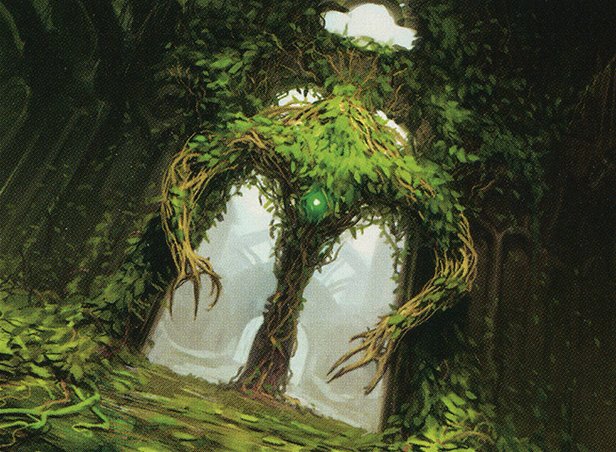Introduction
Hi everyone, I’m Pietro Laudati, aka Maccaciock on MTGO, a Magic player from times long gone. I first approached pauper something like a year ago thanks to the players (and friends) at LP Padua, who also, and most of all, pushed me towards returning to paper Magic.
In this virtual space I was gifted, I’ll try to dissect and explain the build, the matchups and the sideboard plans regarding 4c Gates.
I consider the deck to be fun, diverse, skill intensive and a valid choice overall. After over 250 matches played (considering only those online), a general winrate floating around 65%, several 5-0s, numerous top16 in the Pauper Challenges and a top8 in a Super Qualifier, I thought it would have been interesting to try and write an article to present some data regarding the deck considering the various matchups.
It all started on December 31st 2022 when, while I was waiting to leave in the night after having prepared my luggage, I was contacted by my dear friend Alberto Rascio (rash on MTGO), who told me about this deck he had faced online and that he thought could be powerful if tweaked properly.
After a week of testing, and several changes and edits along the way, we reached this form
Original List by Alvatar, 5-0 Pauper League 28/12/2022
| Creatures (22) 4 Sacred Cat 3 Dawnbringer Cleric 3 Gatecreeper Vine 4 Kor Skyfisher 3 Inspiring Overseer 2 Guardian of the Guildpact 3 Saruli Gatekeepers Instants (8) 3 Ephemerate 1 Destroy Evil 4 Terminate Sorceries (6) 3 Flame Slash 1 Open the Gates 2 Smash to Dust Artifacts (1) 1 Nihil Spellbomb Enchantment (3) 2 Abundant Growth 1 Omen of the Dead | Lands (20) 4 Citadel Gate 4 Cliffgate 4 Manor Gate 2 Heap Gate 4 Basilisk Gate 1 Forest 1 Plains Sideboard (15) 4 Pyroblast 4 Relic of Progenitus 4 Dust to Dust 2 Crimson Acolyte 1 Destroy Evil |
After a week of testing and some changes, we come to this:
5-0 Pauper League 7/1/2023 by _rash_
| Creatures (23) 4 Sacred Cat 4 Thraben Inspector 2 Dawnbringer Cleric 4 Gatecreeper Vine 4 Kor Skyfisher 3 Inspiring Overseer 2 Saruli Gatekeepers Instants (6) 2 Ephemerate 4 Lightning Bolt Sorceries (3) 1 Open the Gates 2 Smash to Dust Enchantment (7) 2 Abundant Growth 1 Omen of the Dead 4 Journey to Nowhere | Lands (21) 4 Citadel Gate 4 Cliffgate 4 Manor Gate 2 Heap Gate 4 Basilisk Gate 1 Forest 2 Plains Sideboard (15) 4 Pyroblast 4 Dust to Dust 3 Relic of Progenitus 2 Dawnbringer Cleric 1 Destroy Evil 1 Omen of the Dead |
.
11th Place Pauper Challenge 1/7/2023 by Maccaciock
| Creatures (23) 4 Sacred Cat 4 Thraben Inspector 2 Dawnbringer Cleric 4 Gatecreeper Vine 4 Kor Skyfisher 3 Inspiring Overseer 2 Saruli Gatekeepers Instants (7) 2 Ephemerate 4 Lightning Bolt 1 Terminate Sorceries (3) 1 Open the Gates 2 Smash to Dust Enchantment (8) 2 Abundant Growth 2 Omen of the Dead 4 Journey to Nowhere | Lands (20) 4 Citadel Gate 4 Cliffgate 4 Manor Gate 2 Heap Gate 4 Basilisk Gate 1 Forest 1 Plains Sideboard (15) 4 Pyroblast 4 Dust to Dust 3 Relic of Progenitus 2 Dawnbringer Cleric 1 Destroy Evil 1 Guardian of the Guildpact |
.
My initial list is slightly different from Alberto’s one, but for April PTQ we come to a tunned list:
6th Place Pauper Super Qualifier 15/4/2023 by Maccaciock
| Creatures (26) 4 Sacred Cat 4 Thraben Inspector 4 Dawnbringer Cleric 4 Gatecreeper Vine 4 Kor Skyfisher 3 Inspiring Overseer 3 Saruli Gatekeepers Instants (7) 2 Ephemerate 4 Lightning Bolt 1 Terminate Sorceries (3) 1 Open the Gates 2 Smash to Dust Enchantment (4) 1 Omen of the Dead 3 Journey to Nowhere | Lands (20) 4 Citadel Gate 4 Cliffgate 4 Manor Gate 2 Heap Gate 4 Basilisk Gate 1 Forest 1 Plains Sideboard (15) 4 Pyroblast 4 Dust to Dust 4 Relic of Progenitus 2 Guardian of the Guildpact 1 Destroy Evil |
.
Deck Strategy
Before analyzing the cards, I think it is better to focus on the strategy of the deck, even though it is pretty simple and straightforward. Our aim is to hit as many land-drops as possible, tutor Basilisk Gate with Gatecreeper Vine and develop our presence in the game through a number of creatures that generate some kind of advantage with their etbs. We then want to activate said Basilisk Gates as many times as possible each turn to overrun our opponent within a few combat steps.
The best case scenario sees us winning as early as turn 6, with one Gate activation on turn 5 and two on turn 6.
.
Manabase
We run 20 lands because of how low our curve is, with an average casting cost of 1.83. This allows us to keep hands with 2 or 3 lands, knowing that we can either tutor additional ones through Open the Gates and Gatecreeper Vine (with the latter being easily re-castable during the game) or we can rely on the ability of many of our creatures to cycle themselves, which will both develop our board state and grant us a number of draws (among which we can find additional land drops).
Our manabase is as consistent-but-slow as it gets, with 12 out of our 20 lands entering the battlefield tapped:
- 4 Citadel Gate
- 4 Cliffgate
- 4 Manor Gate
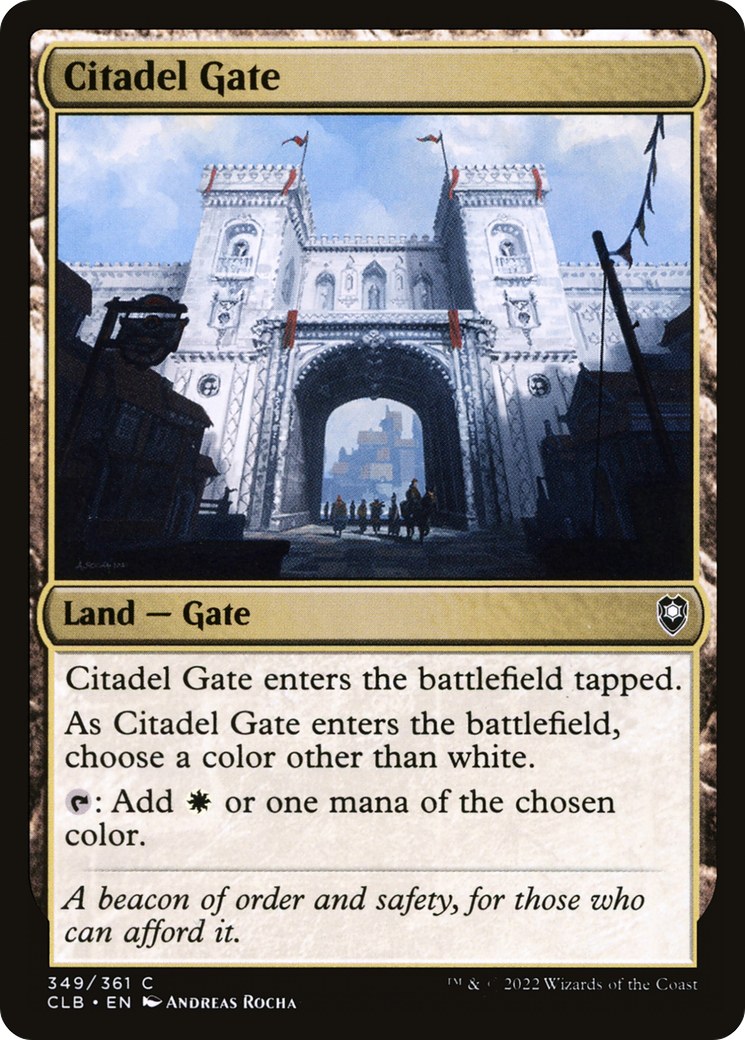
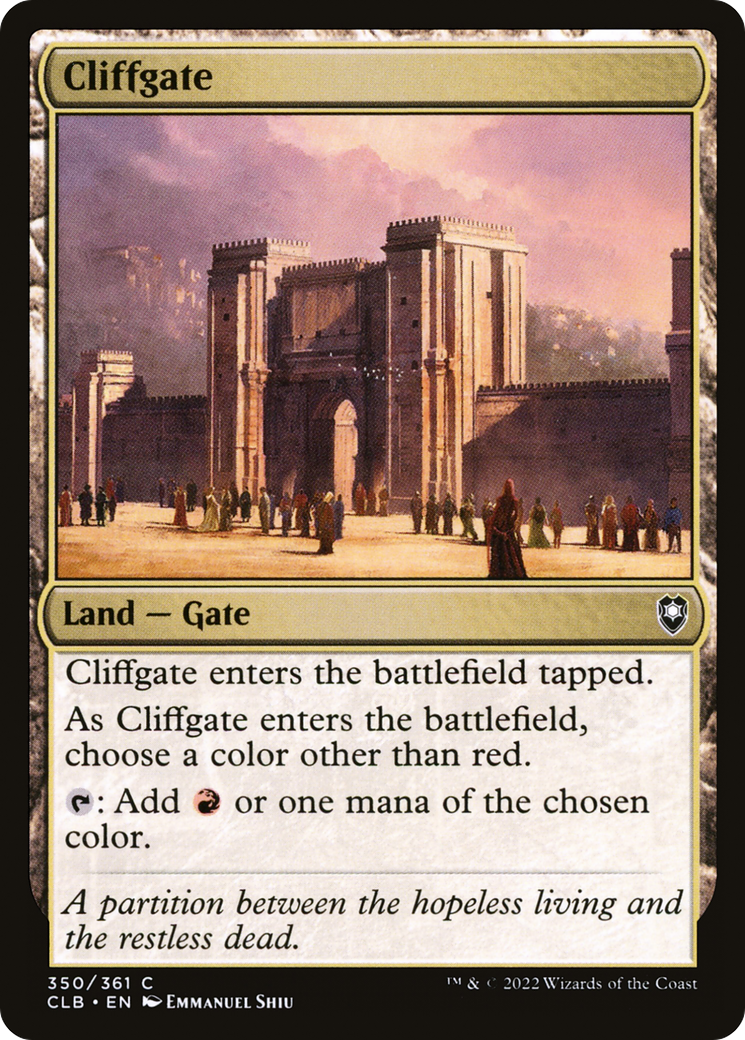
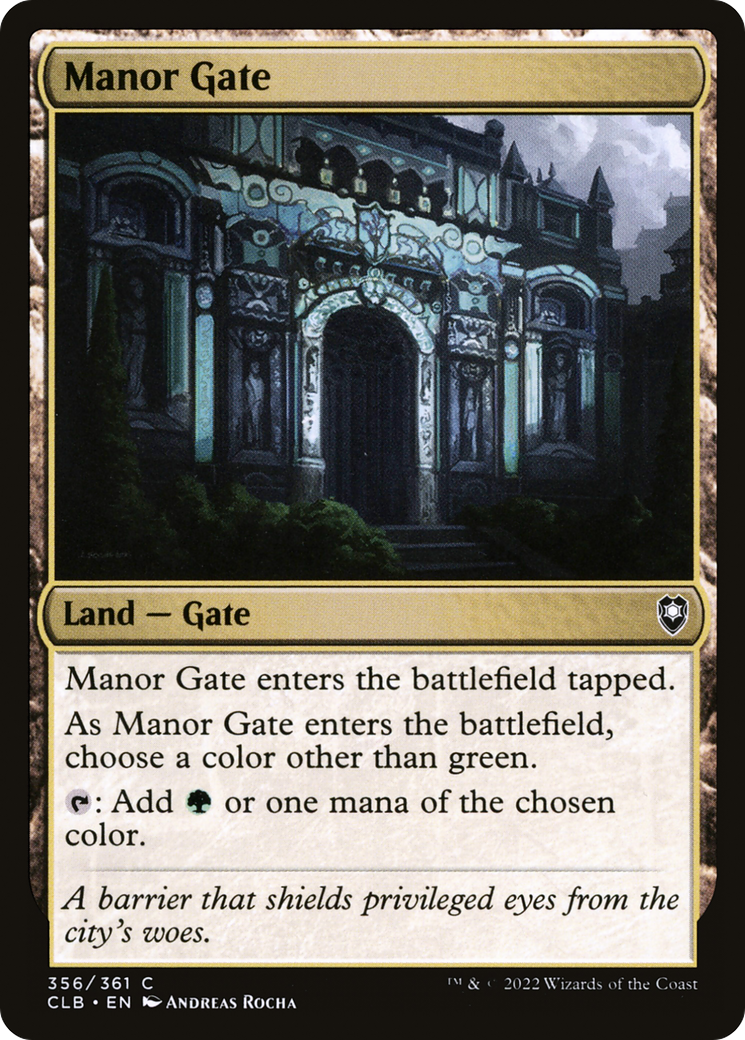
White is our main color, with green and red being supportive colors and black working as a splash.
We run 4 copies each of the tapped gates because we want to make sure we are casting spells of those three colors during the first few turns of the game; on the other hand, we can wait the mid game to gain access to black mana.
White is the color we want to be naming when playing the other two types of gates, as we want to unlock the ability to cast more than one white spell per turn. On the other hand, green and red are more likely to be used just once per turn, even though red might become as relevant as white post-sideboard.
As we are going to play tapped lands during all of our turns, the deck runs 16 1-drops and 18 2-drops; this is also the reason why I chose red over black for removals. In fact, the first grants us access to Lightning Bolt (which is an effective removal on turn 2 despite a second tapped land), while the latter only offers suitable options at 2 or more mana.
For the same reason, Thraben Inspector is a crucial inclusion, as it is a second option alongside Sacred Cat as a creature to deploy on turn 2.
The order in which to play the tapped lands is pretty simple, I’ll give some general guidelines but it’s important to keep in mind that it may change depending on the starting hand and the MU.
Cliffgate and Manor Gate are the first ones we want to play (in this exact order if we have both of them in hand) and, as we said, they are almost always going to tap for white mana. We want to prioritize Cliffgate as it unlocks the turn 2 bolt I talked about above.
Citadel Gate, on the other hand, is the gate we want to play last, as it already taps for our main color and it could also grant us access to the colors we are lacking, including black mana, which is the least present in the shell of the deck.
If there’s ever going to be the need to call coloros different from white with either Cliffgate or Manor Gate, I strongly suggest avoiding calling black with the first, as Terminate requires both black and red mana, hence, having a land that taps for those two colors would mean that we need another gate to be tapping for a “bad” color.
If Citadel Gate is our only colored land and we don’t have any red-or-green card in hand, I suggest calling green with it. In fact, it is crucial to increase our number of lands, which would mainly be achieved through a topdecked Gatecreeper Vine.
The rest of the manabase is composed of 8 untapped lands:
- 4 Basilisk Gate
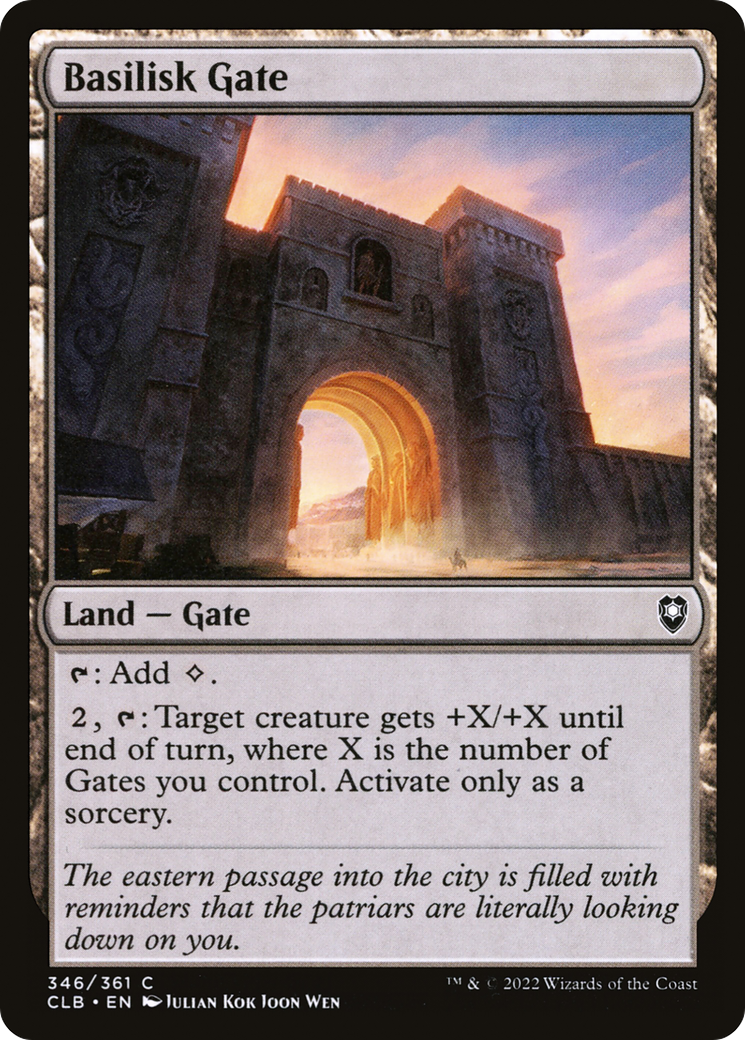
Basilisk Gate is THE card of the deck, without any shadow of doubt.
Our plan is to win activating 1 or more Basilisk Gate to pump our creatures, so I suggest to always have access to at least two of them. Early in the game, we will use the mana coming from the first to activate the second one, then we will start to activate both of them as the game develops and the number of lands in play increases.
- 2 Heap Gate
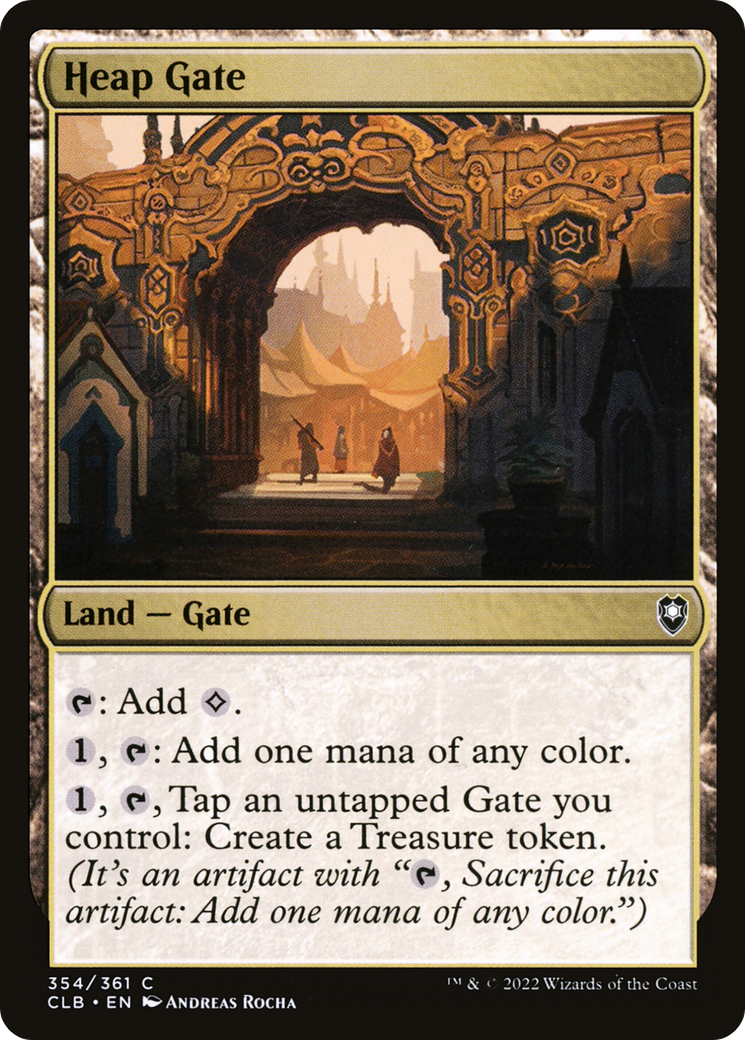
They work as untapped sources of mana to assure us we are playing 3 and 4-drops on curve. They can be tutored with Gatecreeper Vine as a way to fix our colors or as a way to instantly activate Basilisk Gate. They create Treasure tokens that could be useful in grindy MUs against counterspells (in which we want to be casting multiple spells per turn) or if we need colored mana to cast our 4-drops or black cards.
- 1 Plains
- 1 Forest
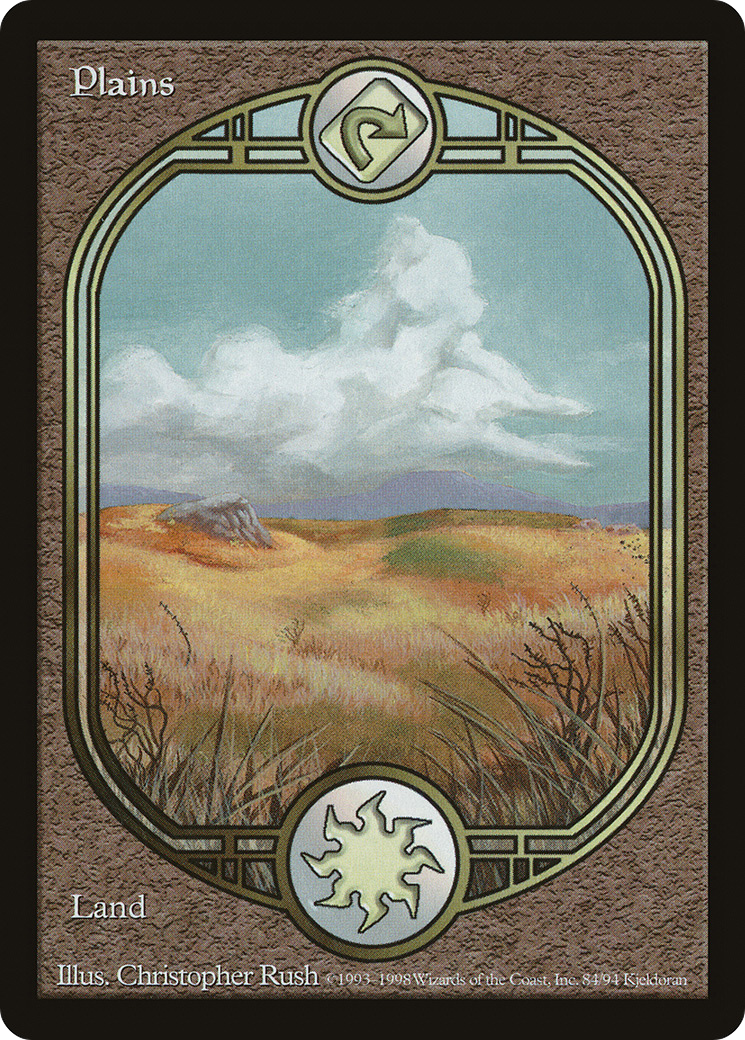
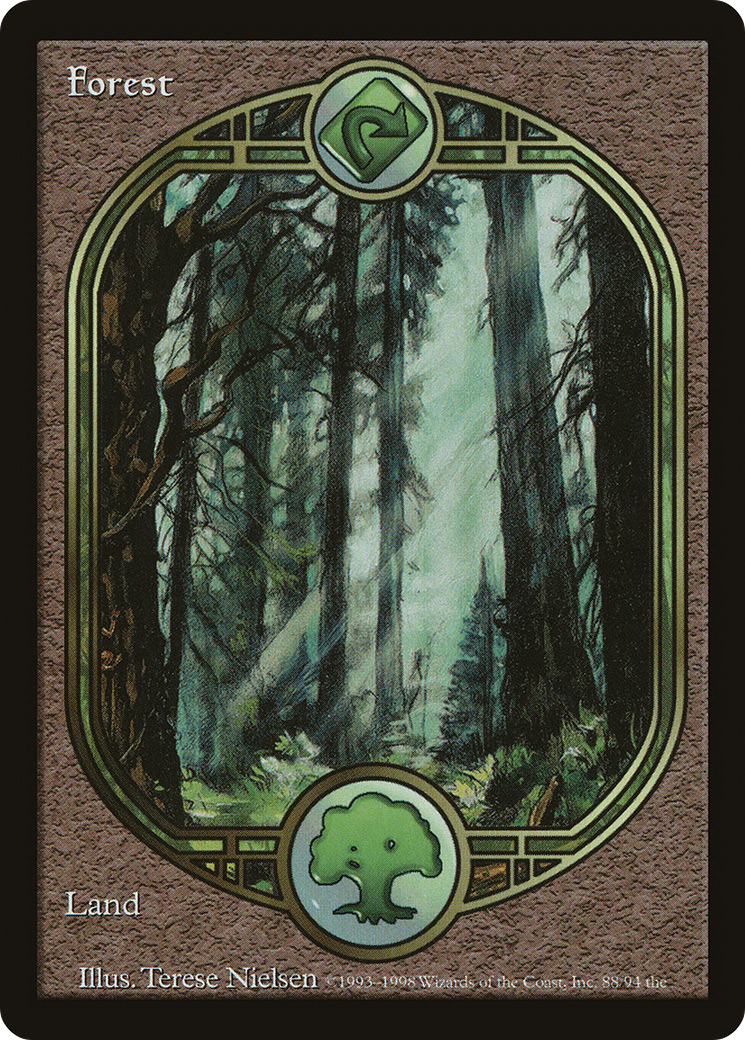
I chose to include a white basic land just because most of our creatures is white, so it can serve as an untapped source in the first turns and it can also be tutored with Gatecreeper Vine if we don’t want to play a tapped land.
Then, I chose to play a green basic over a red one so that we can keep lands with Forest + Open the Gates or Forest + Colorless land + Gatecreeper Vine.
.
Removal Spells
Let’s now move on to the removals present in the deck:
- 4 Lightning Bolt
- 3 Journey to Nowhere
- 1 Terminate
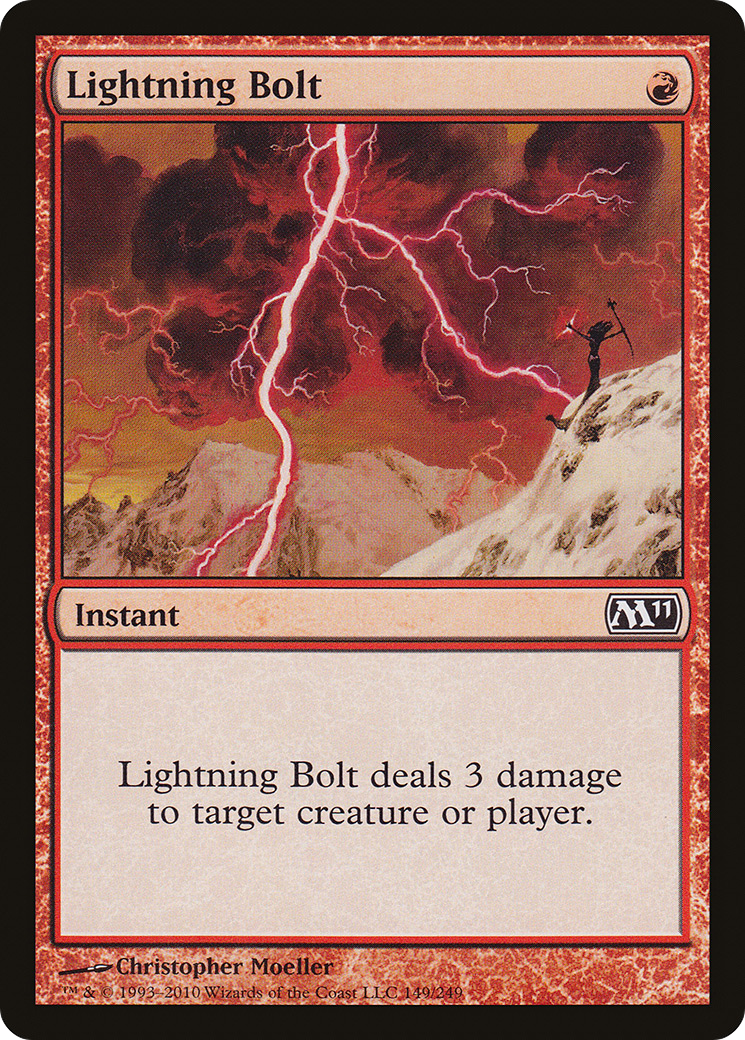
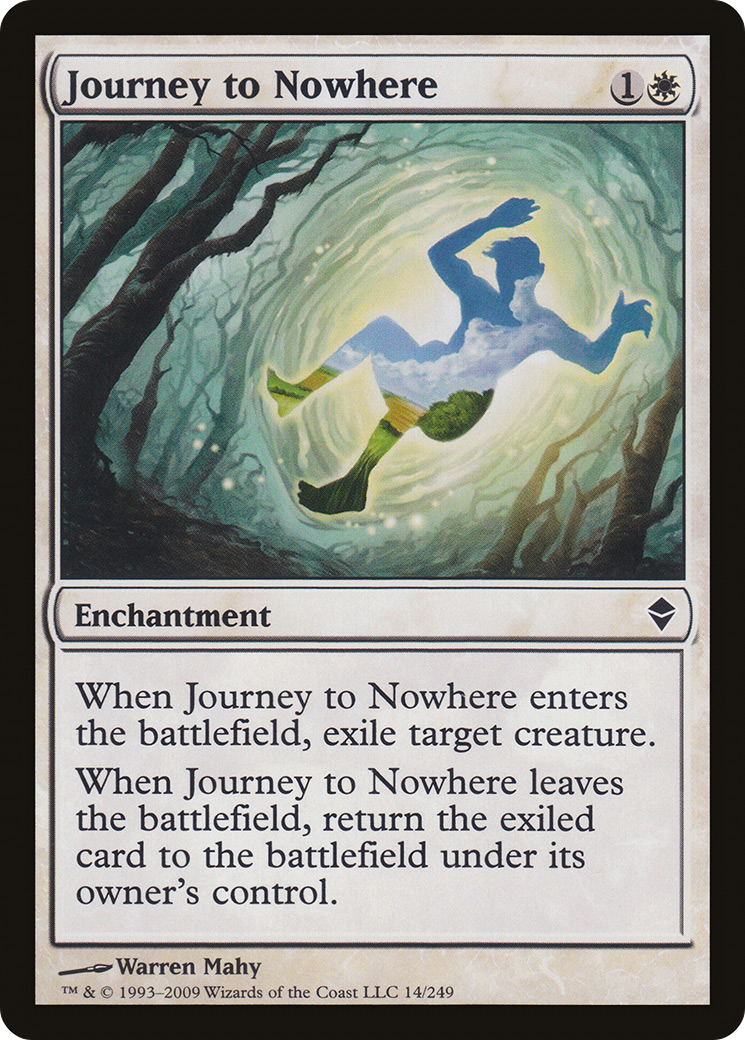
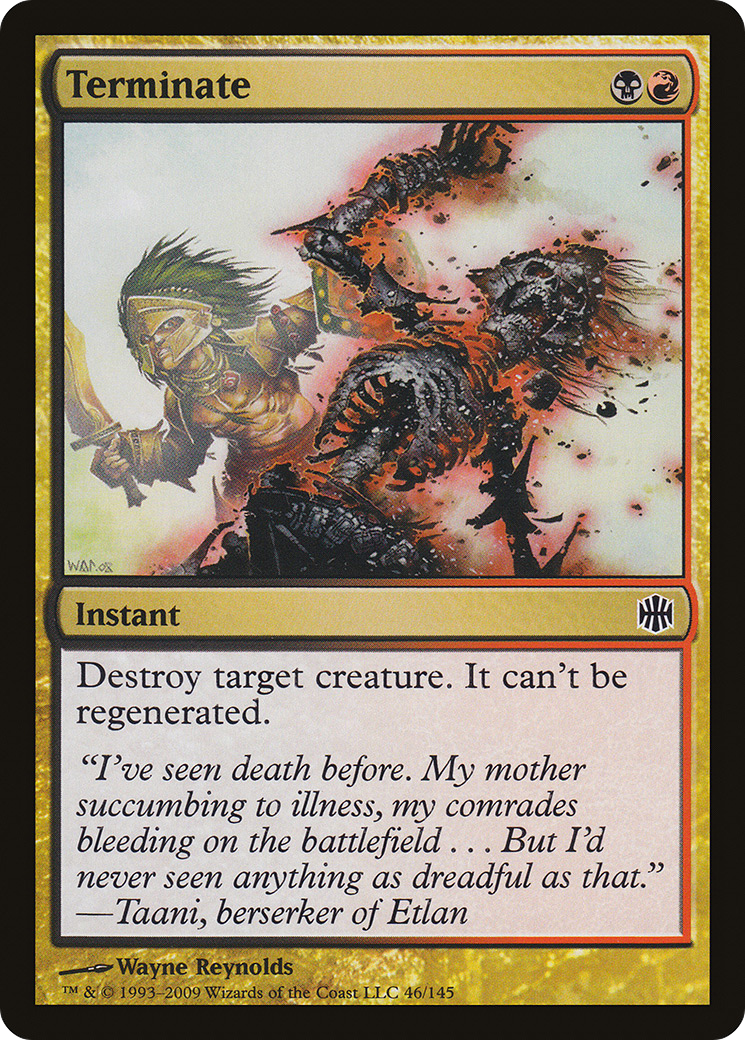
Lightning Bolt is the reason why we are playing red as a secondary color. Other than being a powerful removal spell in the first turn against decks such as monoR, monoU and Boros, it can also remove some creatures in the mid/late game against other archetypes, such as the Gates mirror. Moreover, it gives us reach, which is to say, we know we could kill our opponent with 1 or more Bolts to the face when the board state prevents us from winning through creatures; this last reason is the one that, most of all, lead me to include 4 copies of this card..
Journey to Nowhere, instead, is the main removal of the deck. I chose to run just 3 copies because of the decks that run Dawnbringer Cleric; in fact, in those MUs, Journey struggles and I usually board out 1 or 2 copies, as the Lightning Bolts can easily handle the situation.
Nonetheless, it is the strongest removal against the decks without Clerics, considering that it can hit also indestructible creatures (e.g. the lands animated by Kenku Artificier) and it can be bounced with Kor Skyfisher if it targeted an animated land or a token. I also used it against decks that swarm the board (e.g. Elves) to slow down their initial sprint before bouncing it back to my hand.
It is also interesting to use it in the three-card-combo with Kor Skyfisher and Ephemerate: with the Skyfisher already in play, we cast Journey to Nowhere targeting the creature we want to exile; with this trigger on the stack, we Ephemerate the Skyfisher, bouncing the enchantment. In this way, the second part of Journey’s textbox will resolve before its etb, permanently removing the creature and allowing us to play ita gain on a different target.
Terminate replaces the fourth Journey to Nowhere that was present before the inclusion of this instant spell. I chose to play Terminate because, even though it doesn’t really fit with our colors (which is why it is only a one-of), I want to have a fifth instant-speed removal alongside the four Lightning Bolts. Moreover, it can be a valid alternative to Journey to Nowhere in the MUs where the latter struggles, such as those against Dawnbringer Cleric mentioned before; it destroys Guardian of the Guildpact and, most of all, it isn’t a card opponents are expecting to play against, given our color combination, hence making it difficult for them to play around it.
.
Deck Engine
With “deck engine” I refer to all those creatures that make us “advance our game”, which is to say, they either cycle themselves or they develop our strategy.
- 4 Thraben Inspector
- 3 Inspiring Overseer
- 4 Gatecreeper Vine
- 4 Kor Skyfisher
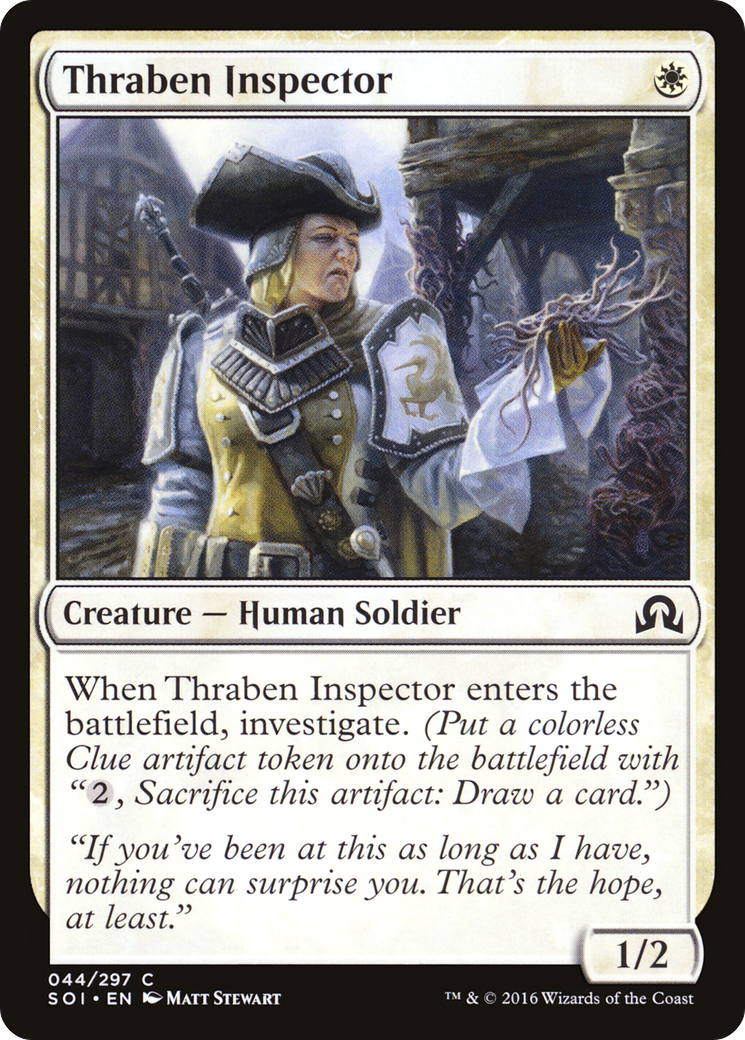
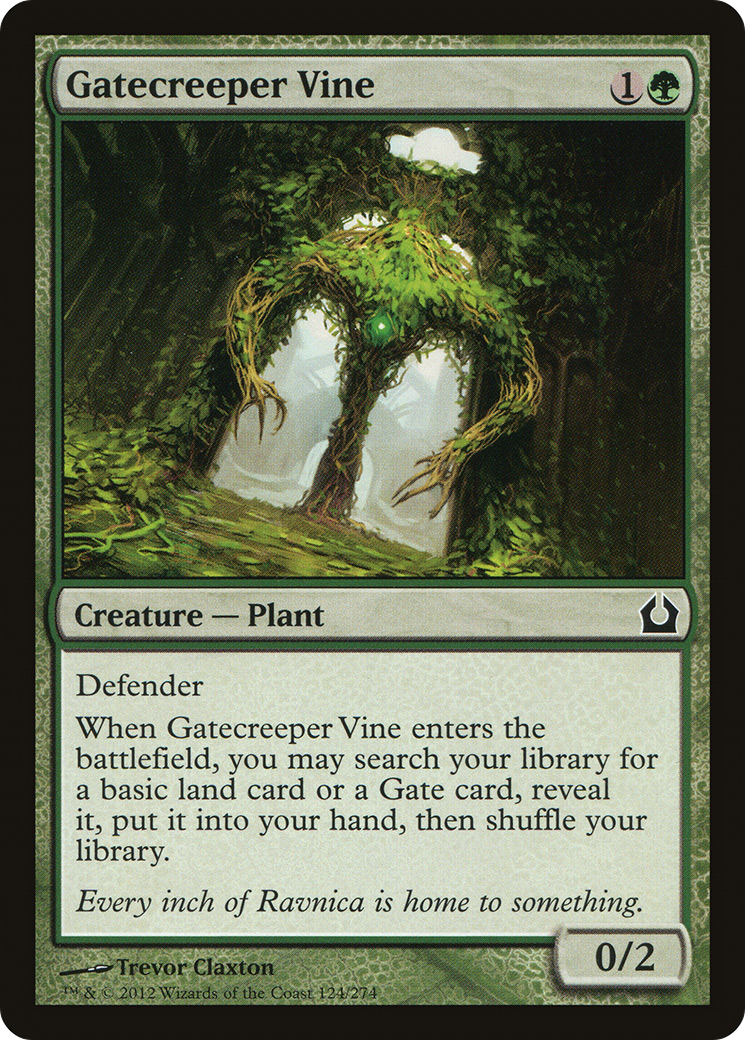
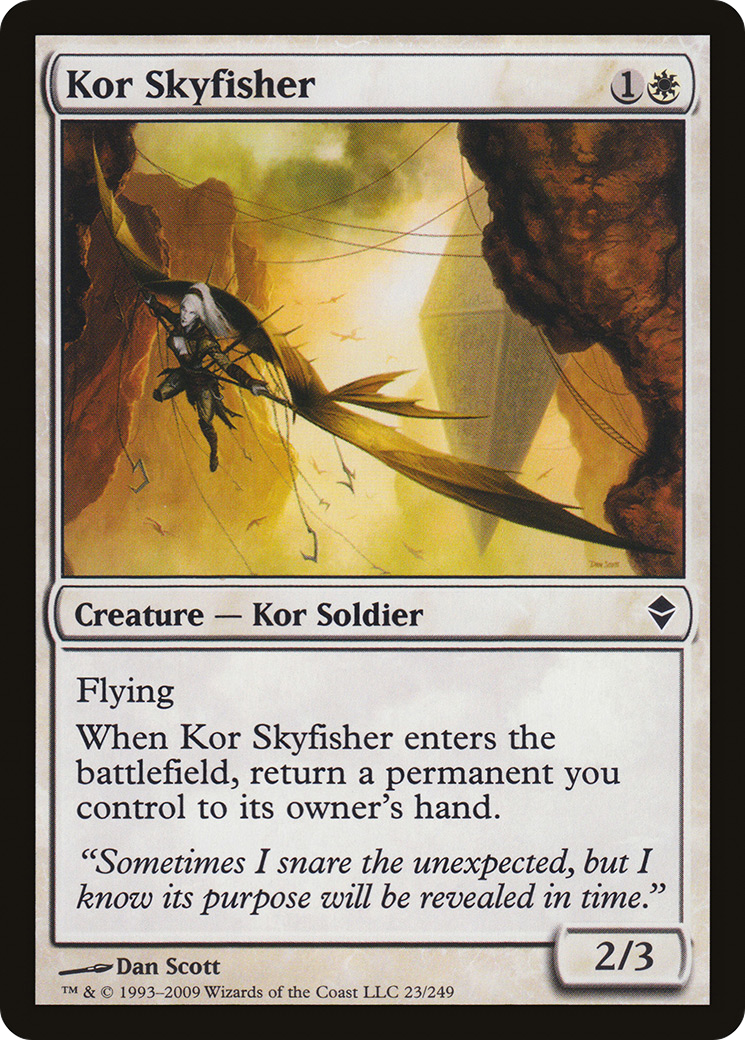
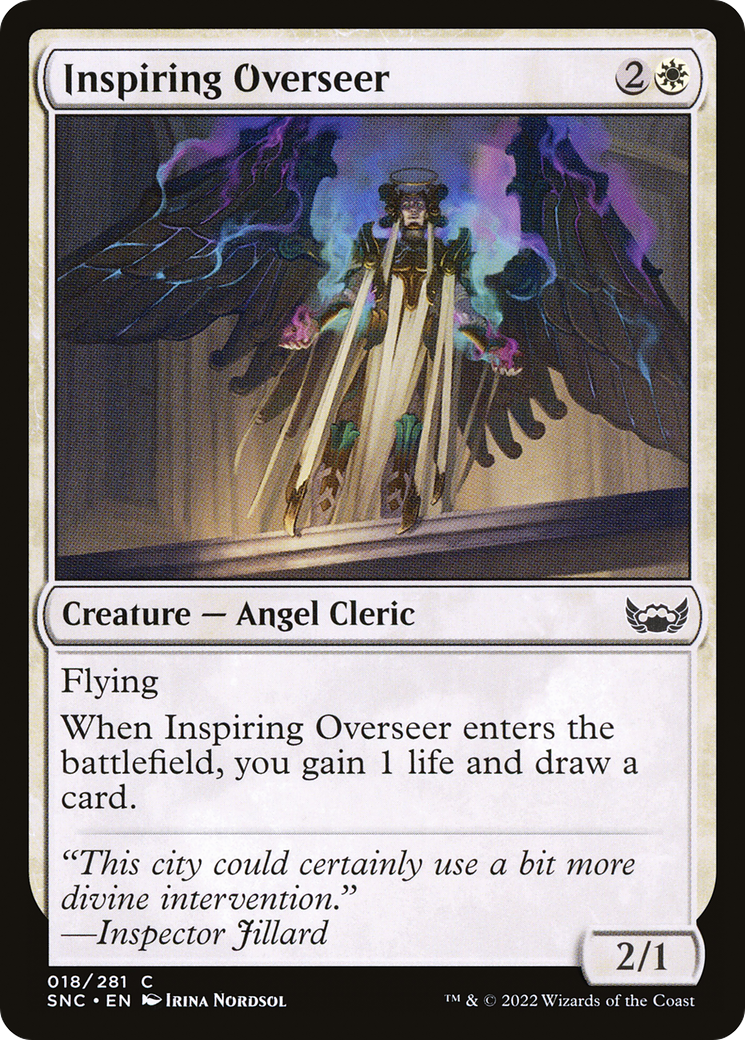
Thraben Inspector is the card that allowed the deck to exist. It is a 1-drop that cycles itself, blocks in the early game and can be pumped with Basilisk Gate in the mid/late game.
Inspiring Overseer is an evasive cycling creature. It can deal some damage early before becoming a lethal threat with Basilisk Gate. It is a 3-of because I always want to see at least one of them but I never want to have two copies in my starting hand.
Gatecreeper Vine is the reason why we play green mana, other than being the reason why, in my opinion, the deck is worthy playing: why should we limit ourselves to 4 Basilisk Gates when we can play 8 copies of them?
It blocks the creatures on the ground while we establish a flying race. It is perfect fodder for opponents’ Chainer’s Edict. Also, it can tutor the colors we need when we are mana-screwed.
Kor Skyfisher is another evasive drop, which both attacks and blocks well, and allows us to repeat the etbs of our creatures if we need to do so. I included it in the deck engine because it makes us bounce and re-deploy all the creatures that make us “advance our game”, Gatecreeper Vine above all. Moreover, it can hamper our opponent’s strategy i fit targets cards like Dawnbringer Cleric or Saruli Gatekeepers, which don’t generate card advantage but are useful tempo-wise and board-wise.
.
Support Creatures
With “support creatures” I refer to the remaining creatures, which don’t develop our gameplan but make the game progress thanks to their abilities.
- 4 Sacred Cat
- 4 Dawnbringer Cleric
- 3 Saruli Gatekeepers
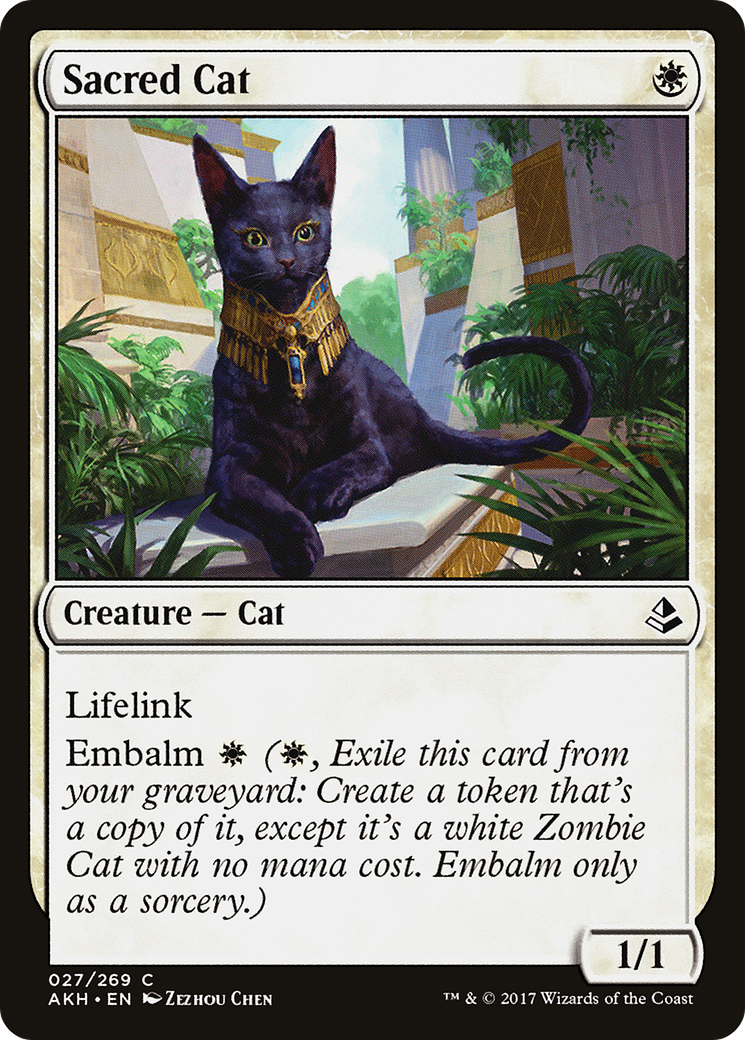
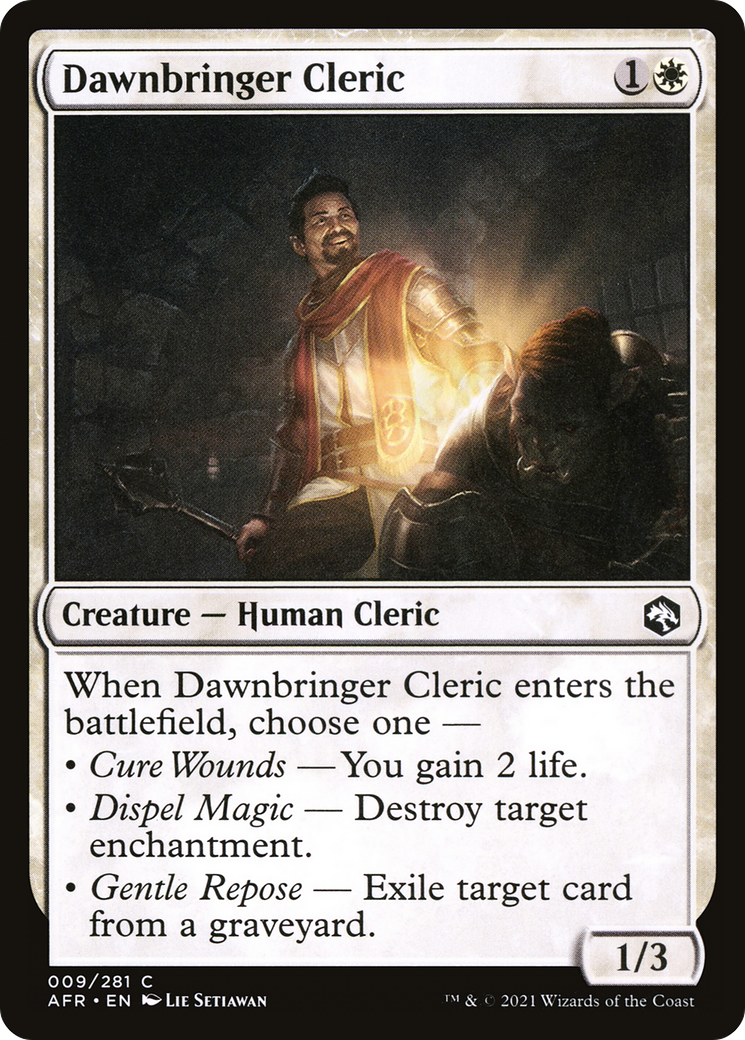
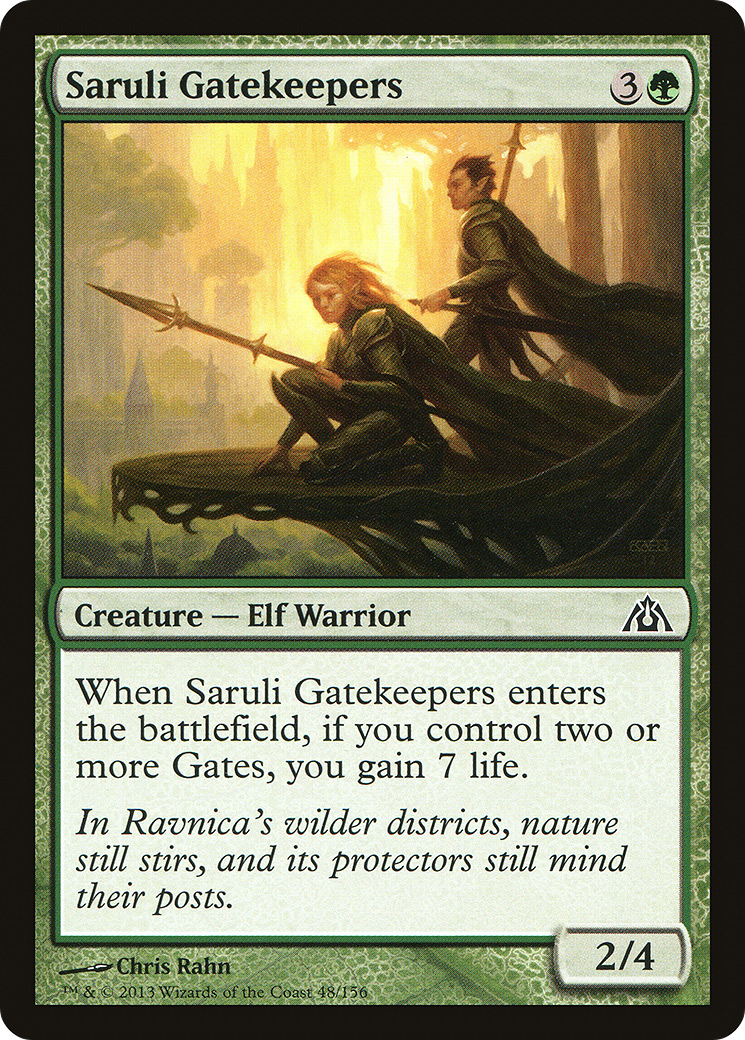
Sacred Cat is the reason why Gate decks exist and white is played in said decks. It turns the race in our favor if it is pumped with Basilisk Gate and it always needs to be removed two times. Gaining large quantities of life points allows us to stall the game before closing it with evasive creatures.
Dawnbringer Cleric is the hero of the deck. It helps us against enchantments (which are extremely widespread in the format at the moment), it blocks well and it can make us gain 2 life points against aggro decks and it also removes the cards with flashback, embalm or retrace (as well as any other kind of recursion) from the graveyard.
I originally ran only 2 copies as I thought its 1/3 body wasn’t good enough in the mid-late game, then I included the third copy, before playing the whole playset. There are various reasons behind this choice; first, I understood that every creature becomes a menace when pumped with Basilisk Gate, regardless of its base power and toughness. Then, if not answered, they can singlehandedly block entire strategies, such as those revolving around Makeshift Munitions or Prismatic Strands. Lastly, they are irreplaceable against monoR, as they grant 2 life points, they block all the tokens, they chump-block a Monastery Swiftspear or they are removed by a burn spell. Basically, they become 2-for-1 in almost every game.
Saruli Gatekeepers is a 3-of as a clear meta-call against monoR, which represents almost 20% of the online metagame. Its 2/4 body, the 7 life points it gains and the possibility to recur it basically close the game by themselves.
It’s extremely good against monoU, UR faeries and Boros Synth as well; moreover, we shouldn’t underestimate it in the matchup against Affinity, as it can block the Frogmites and annul two attacks from a Myr Enforcer, allowing us to start a counter-race.
Overall, it’s not the best card against every deck, but more often than not it’s a valuable option.
Saruli Gatekeepers is one of the flexible spots of the deck, which means it can be easily moved to the sideboard or cut entirely depending on the meta. In fact, if we expect to play against many midrange (e.g. BW or Gates) or tempo/control decks (e.g. Jeskai, UB Terror), we can move 1 or 2 copies of Gatekeepers to the side in exchange for an equal amount of Guardians of the Guildpact, or even include 1 copy of Coalition Honor Guard.
Anyway, given the current meta, I’d say that at least one copy is mandatory in the main deck as an additional lifegaining engine alongside Sacred Cat and Dawnbringer Cleric, also given its synergy with Ephemerate and Kor Skyfisher.
.
Utility Cards
Lastly, let’s go over the cards that support our game and can be played in various situations, both in the early and mid-late game, as they grant the deck additional consistency.
- 1 Open the Gates
- 2 Smash to Dust
- 2 Ephemerate
- 1 Omen of the Dead
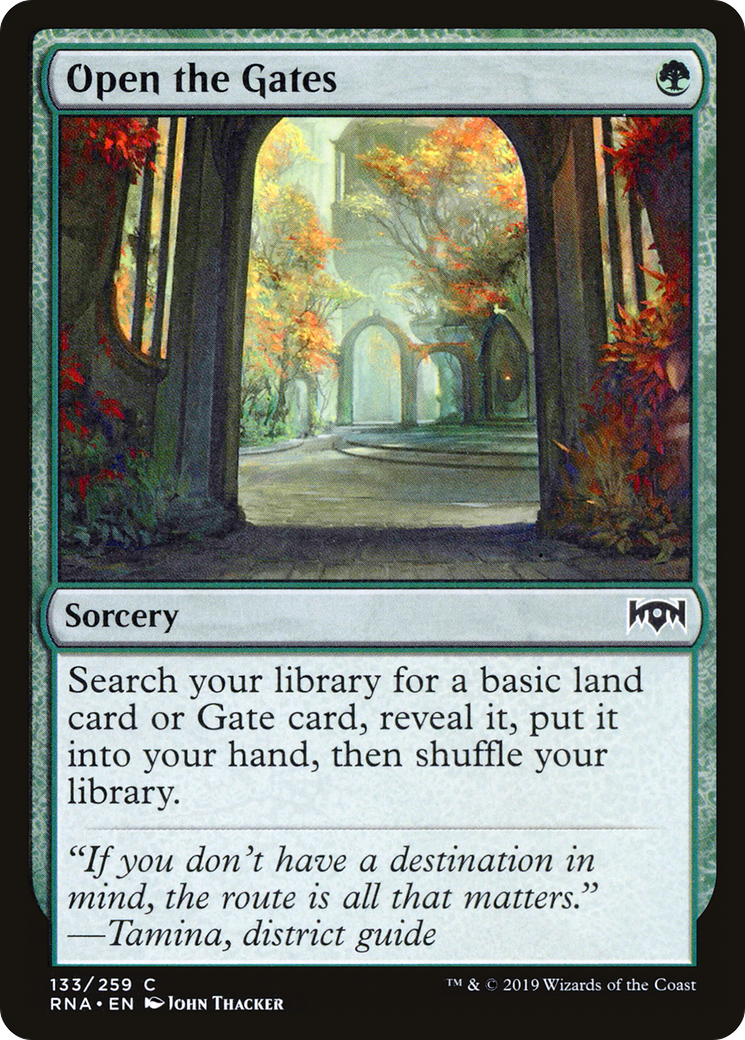
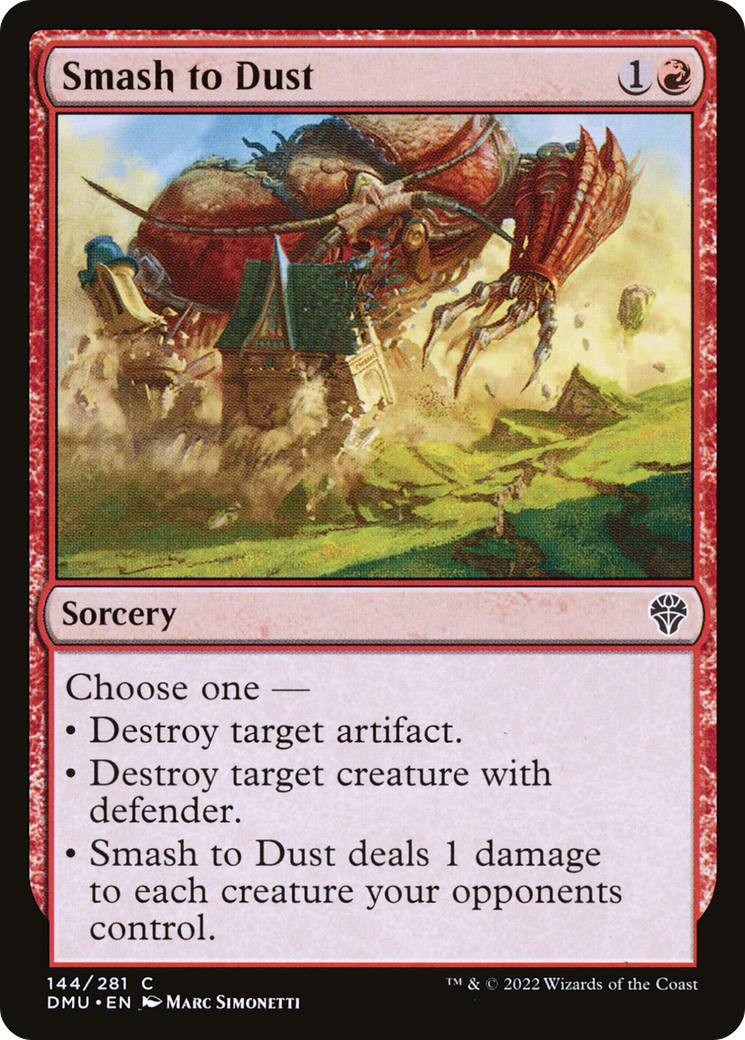
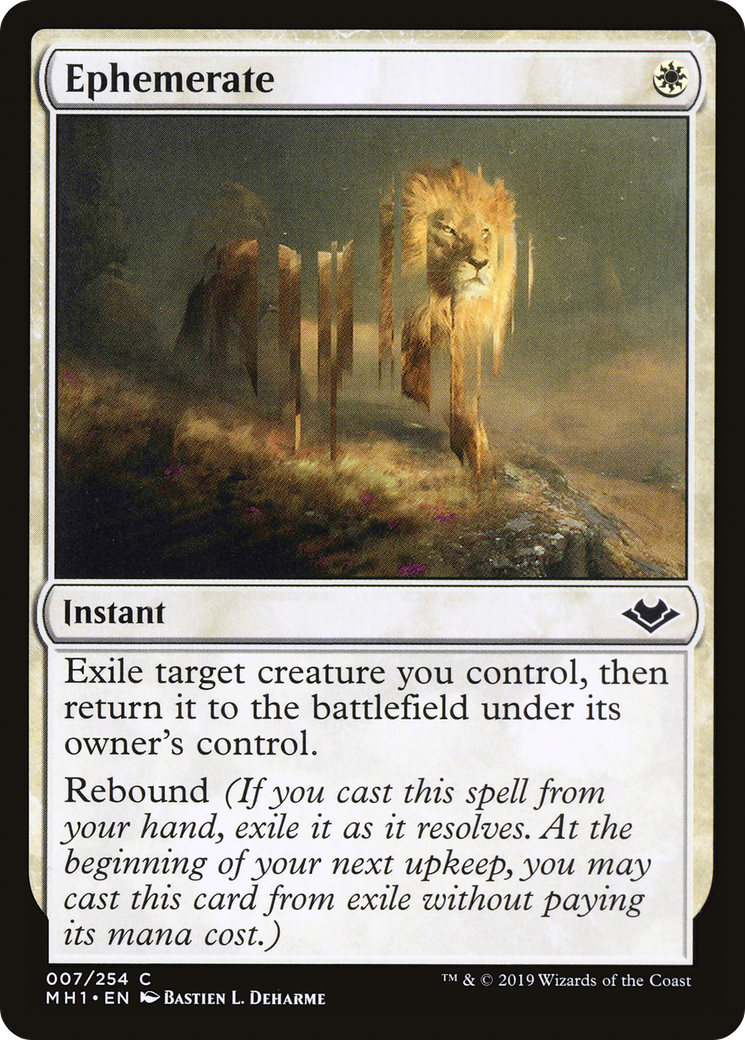
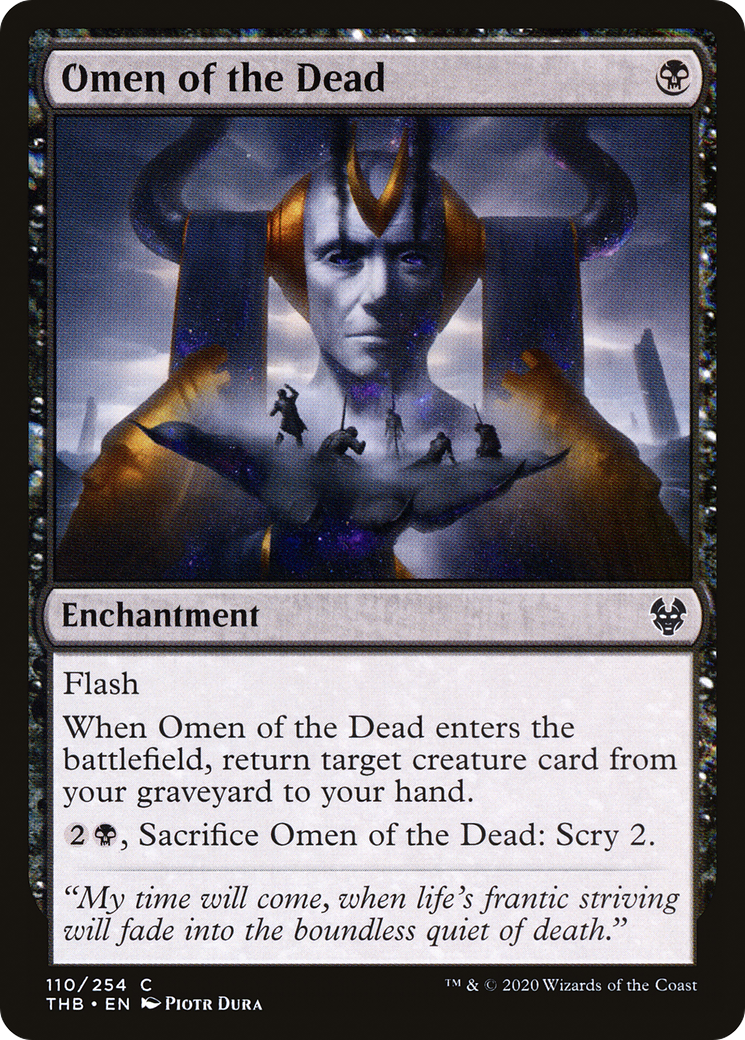
Open the Gates works as the 21st land, it helps us find a color we may be missing or it can be a fifth Demonic Tutor for our Basilisk Gate.
It could be cut in favour of a second basic Plains, which would give us a bit more of consistency regarding the percentages of 7-cards-keeps, but I place the added possibility of tutoring Basilisk Gate in the late game much higher than a slight improve in the chances to keep our starting hand without mulliganing.
We only play it as a 1-of because it’s always useful but it doesn’t generate any kind of advantage on its own, so running 5 land tutors (which means we are playing 9 potential Basilisk Gates) is the right measure.
Smash to Dust is useful in very different matchups. It can be a wrath effect against a board of X/1s, it can remove some pesky artifacts and the cherry on top is destroying walls, which is extremely valuable against Walls Combo and UW Familiars. Having such a low casting cost, it fits perfectly with our strategy.
Ephemerate helps developing our game, blinking all the creatures with an etb. In the early game, it can be used to blink a Gatecreeper Vine and tutor 2 lands, while in the mid-late game it protects the creatures that would get removed in response to Basilisk Gate’s activation, it nets us additional cards if we use it on a Thraben Inspector or an Inspiring Overseer or it can gain us additional life points against aggro decks if played on a Saruli Gatekeepers.
It’s also worth noticing the possibility to use it as an instant-speed Dawnbringer Cleric activation, which could remove a card from our opponent’s graveyard in response to an Archaeomancer/Mnemonic wall etb or to stop Goblin’s or Altar Tron’s combo. Also, it can be useful against GW Auras, destroying an enchantment in combat to give us a good block.
We shouldn’t underestimate its synergy with Kor Skyfisher either. It can bounce a land, saving it from a land-destruction effect, it can protect a Guardian of the Guildpact from a multicolored interaction from our opponent (as Skyfisher doesn’t target) and it can also target an Omen of the Dead to bounce it, redeploy it and then bounce it again.
Omen of the Dead is the card tha gives our mid-late game consistency, as it allows us to develop our aggressive flying strategy recurring one or more Kor Skyfishers. Then, every following Skyfisher will also grant us a creature from the graveyard.
It’s a perfect card for our late game plan, but it can perform in the early game as well when it gets us back a useful creature depending on the MU.
Its activated ability (aka, sacrificing it to scry 2) is very rarely used, perhaps only when both players need to topdeck something and we are also behind on the board. In any other scenario, it is pivotal to keep it in play to unlock the recursion with the Skyfishers. This synergy is a must have, given how the splash is free thanks to the 14 Gates we run and how it can win us the games that reached a stalled situation.
I used to play 2 copies of Omen of the Dead, given how well it interacts with the Skyfishers, but with time I noticed a series of problem with the second copy. First of all, it clearly has a negative synergy with Relic of Progenitus; then, the manabase couldn’t really afford it being a 2-of, to the point that it was difficult to cast it in the early game; lastly, it is a card too clunky and redundant to be played in multiple copies. Hence, I think that 1 is the sweet spot to add consistency and having options in the late game.
Omen of the Dead, alongside Sacred Cat, in the main board is the reason why Relic of Progenitus starts in the side.
.
Sideboard
The deck is very well-positioned in the online meta and it matches well against monoR, Affinity, monoU and UB Terror, which are all very present right now.
This is the sidedeck:
- 4 Dust to Dust
- 4 Pyroblast
- 4 Relic of Progenitus
- 2 Guardian of the Guildpact
- 1 Destroy Evil
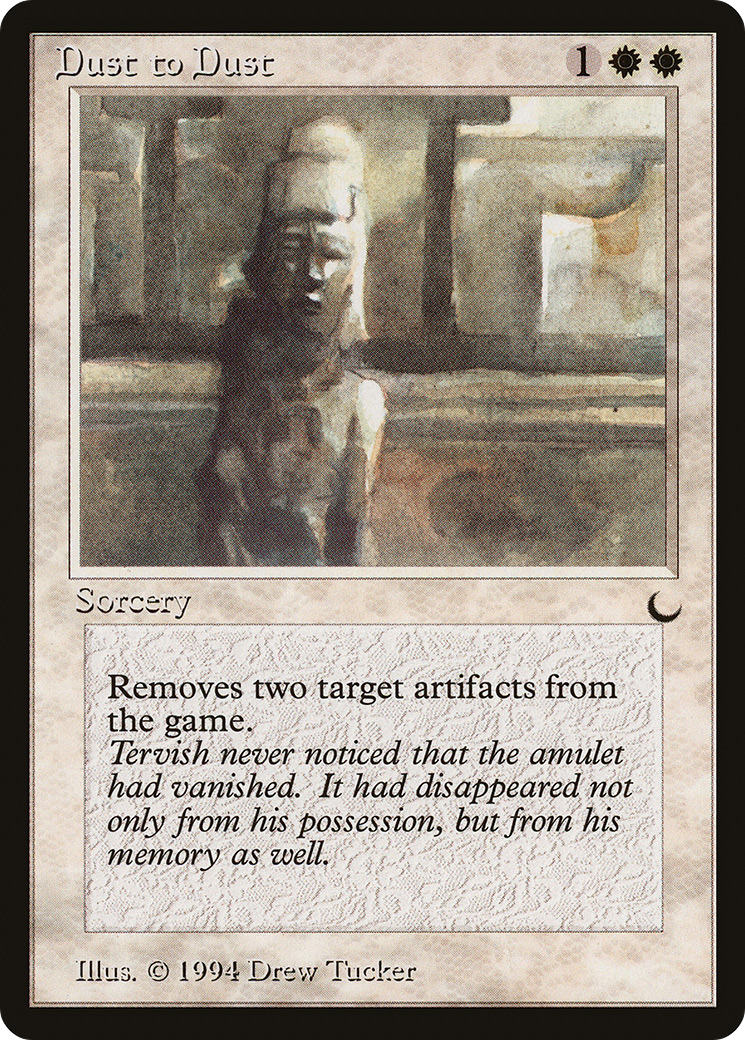
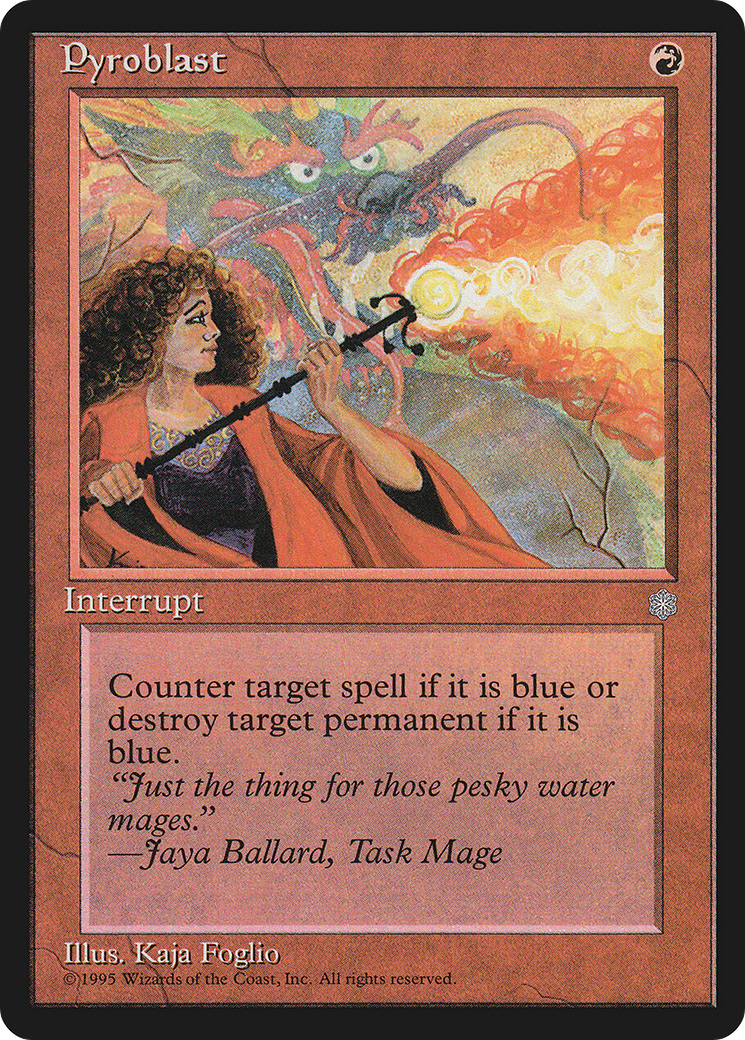
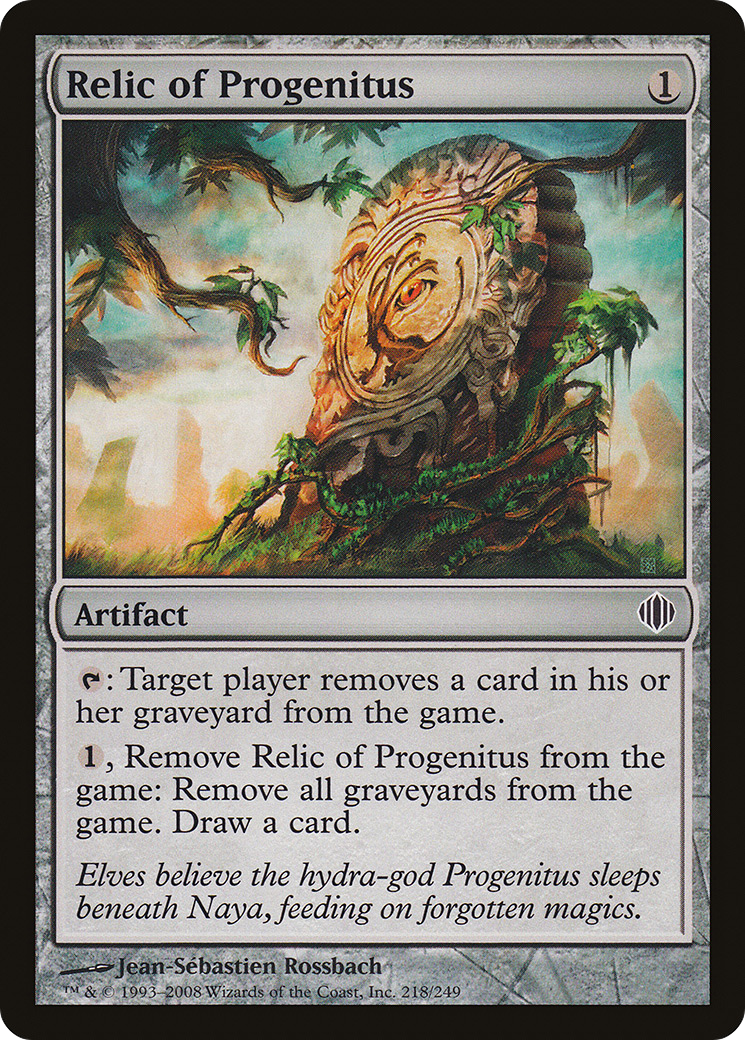
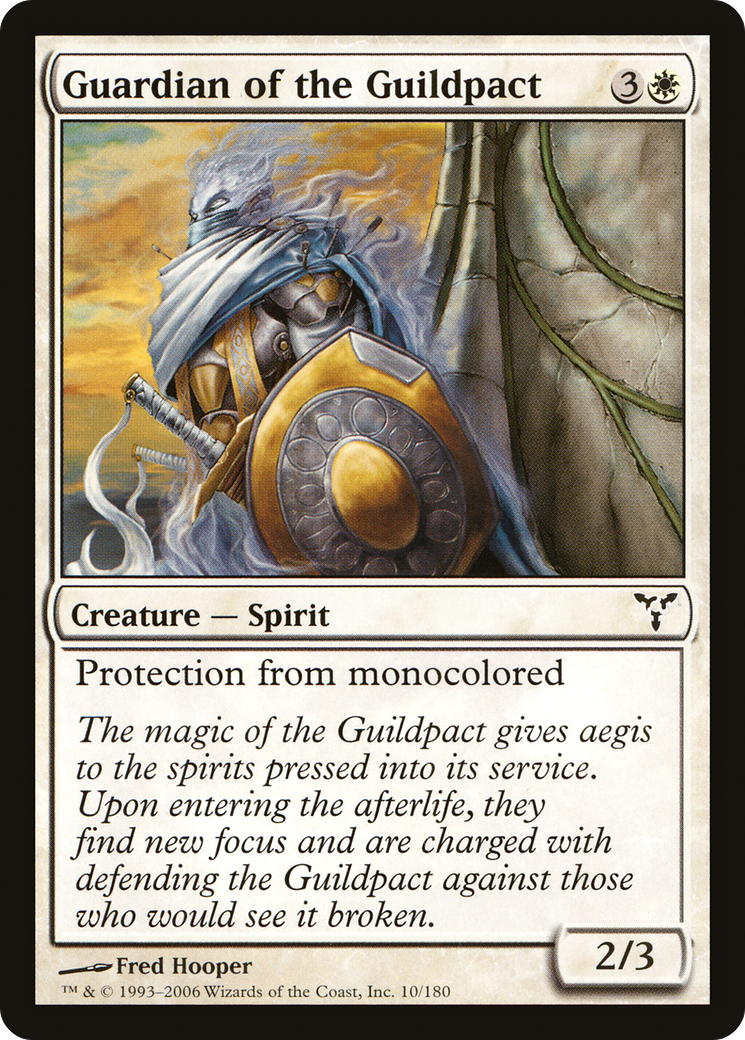
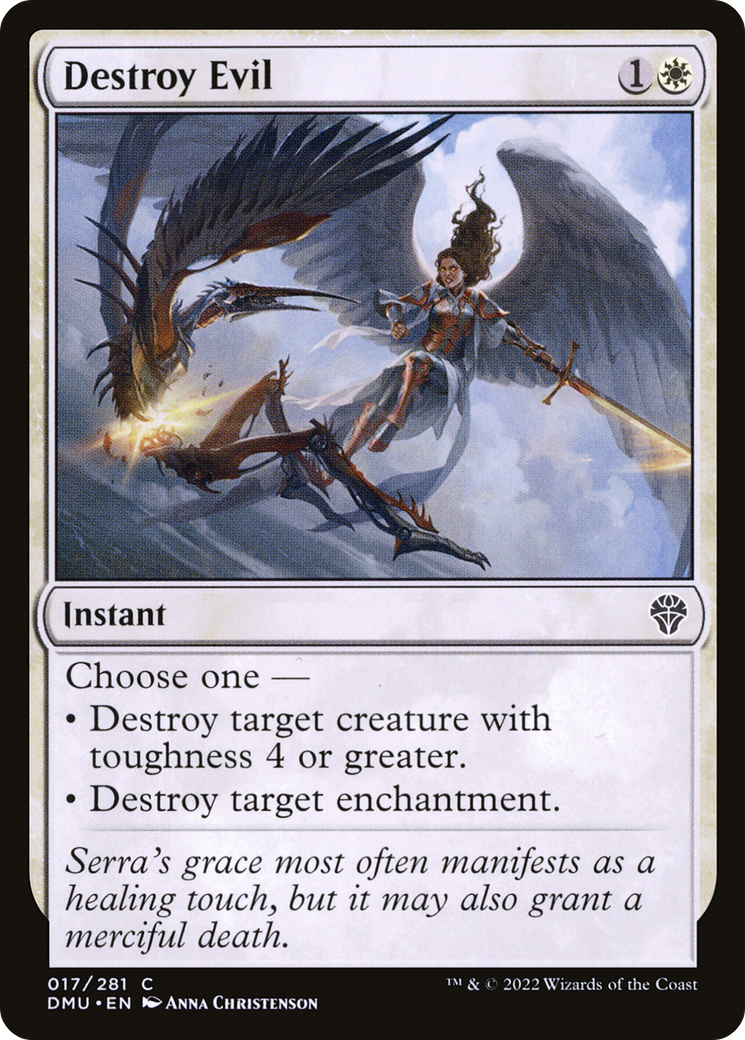
Playing white and red grants us access to 2 of the most powerful sideboard cards in the current meta, Dust to Dust and Pyroblast. The first one helps us win against Affinity and artifact-based strategies in general, while the second perfectly balances the MUs againt blue decks; hence, we want to run 4 copies each.
Another card we find as a 4-of is Relic of Progenitus, which performs extremely well against combo decks revolving around the graveyard. Even though it really doesn’t synergise with our strategy, it’s crucial to try and avoid losing those games. I chose to run 4 copies as we always want to play as early as possible to immediately deny combo decks access to recursion.
Given the recent increase in the presence of UW Familiars and monoU Faeries in the meta and the lack of Goblin Combo, Altar Tron and Cyclestorm, I am considering to cut some copies of this card to give space to additional Red Elemental Blasts, which are much more effective against UW and equally powerful against monoU and UB Terror.
Guardian of the Guildpact was included to win all the MUs in which the board is easily stalled or in which there are a lot of removals, or answers in general, to our creatures. Moreover, against combo decks such as Elves or Walls it can run past their creatures.
Destroy Evil, instead, becomes useful in the MUs where there are many enchantments we want to remove as soon as possible, GW Auras above all. On a more general note, it serves as a fifth enchantment removal option and possibly as a creature removal as well. Against Affinity it removes Makeshift Munitions as well as Gurmag Angler, Gearseeker Serpent and Myr Enforcer; it removes big creatures in the midrange mirror against BW ephemerate, UB Terror, while in the actual mirror or against Cawgate it can destroy The Modern Age and Journey to Nowhere (supposing our opponent doesn’t cut them), Basilisk Gate-pumped creatures and, most of all, Coalition Honor Guard.
Let’s now go over some matchups, considering my sideboard plans and my winrates. I’ll only take into account the decks against which I played a reasonable number of games in the online meta.
.
MU Super Positivi
Terror

- UB Terror score: 21-2 91% wr
- UR Terror score: 4-0
- MonoU terror score: 2-0
I put these 3 decks together because, even though I only played a few against the second and the third, the matchup is basically the same. Notably, against the black-less versions, we want to keep the Lightning Bolts to remove Delver of Secrets.
Tips: always look for a Sacred Cat in the early turns, gaining even just one life point means having an extra turn, given that the Terrors reduce our life total in chunks of 5 with each attack.
Dawnbringer Cleric can be cast on turn 2/3 as well, even if there aren’t spells with flashback in our opponent’s graveyard. Removing a spell from the yard means they have access to one less mana, which usually means the monsters will hit the board one turn later.
Side in UB Terror:











Side Out UB Terror:








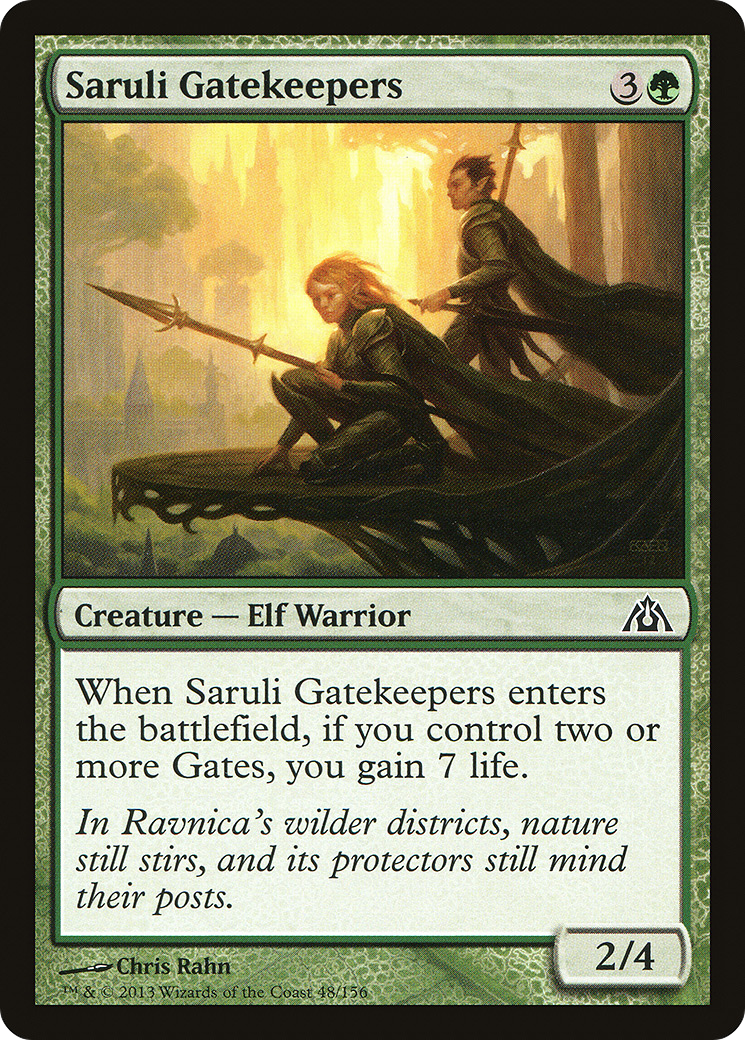


Side in UR Terror e monoU Terror:







Sideo Out:
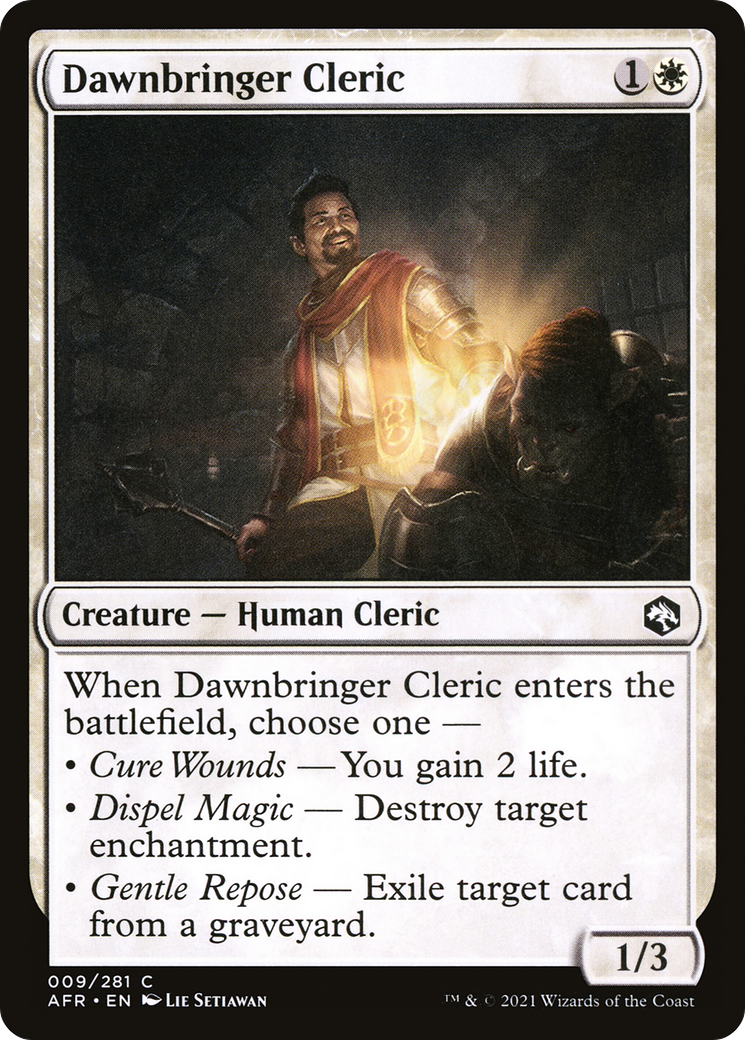






Against UR and monoU, we don’t need Relic of Progenitus and Dawnbringer Cleric, as their plan is not turn-3 Tolarian Terror and they don’t run spells with flashback such as Deep Analysis or Chainer’s Edict. Also, as they don’t have free removal spells (e.g. Snuff Out), Ephemerate is a viable option to save our creatures from burn spells. Lastly, Saruli Gatekeepers is needed to even out the life point gap generated by Delver of Secrets in the early game, so that we don’t have to play under the constant threat of a Lightning Bolt.
.
MU Positivi
I refer to those MUs with a winrate between 80% and 60.
Among them, we find:
- Boros Synth score: 12-4 75% wr
- GW Aura score: 10-4 71% wr
- UR Faeries score: 10-4 71% wr
- Affinity score: 18-9 67% wr
- UW Gates score: 12-6 67% wr
- MonoR Synth/Burn score: 42-22 66% wr
- RG Ponza score: 11-6 65% wr
- BR Burn score: 10-6 63% wr
- MonoU Faeries score: 12-8 60% wr
.
Boros Synth

Against Boros Synth, the MU is fairly easy, as they need to use a bunch of resources to answer our threats, they suffer Sacred Cat a lot, Saruli Gatekeepers blocks and makes the race uneven, Kor Skyfisher blocks the Glint Hawks, Dawnbringer Cleric removes both their Journey to Nowhere and their Makeshift Munitions and post-side we have Dust to Dust.
Side In:




Side Out:




2-for-1s are better than 1-for-1s, so Smash to Dust isn’t really worth it, also against Kuldotha Rebirth’s goblins in my opinion, given how we can easily manage the board on the ground with our 1/Xs.
Journey to Nowhere isn’t that good, given how many versions run Dawnbringer Cleric, but it helps us remove the tokens from either Synth or Barbed Battlefist before being bounced with Kor Skyfisher.
I only keep one copy of Ephemerate to potentially blink a creature in response to a removal spell or to gain 7 additional life points with Saruli Gatekeepers.
.
Aura

This MU basically revolves around the numer of Dawnbringer Clerics we see in the early game, alongside how many Ephemerates and Kor Skyfishers we have access to. If their start isn’t perfect, we can easily stall the game and gain advantage in the race thanks to Sacred Cat.
Side In:



Side Out:


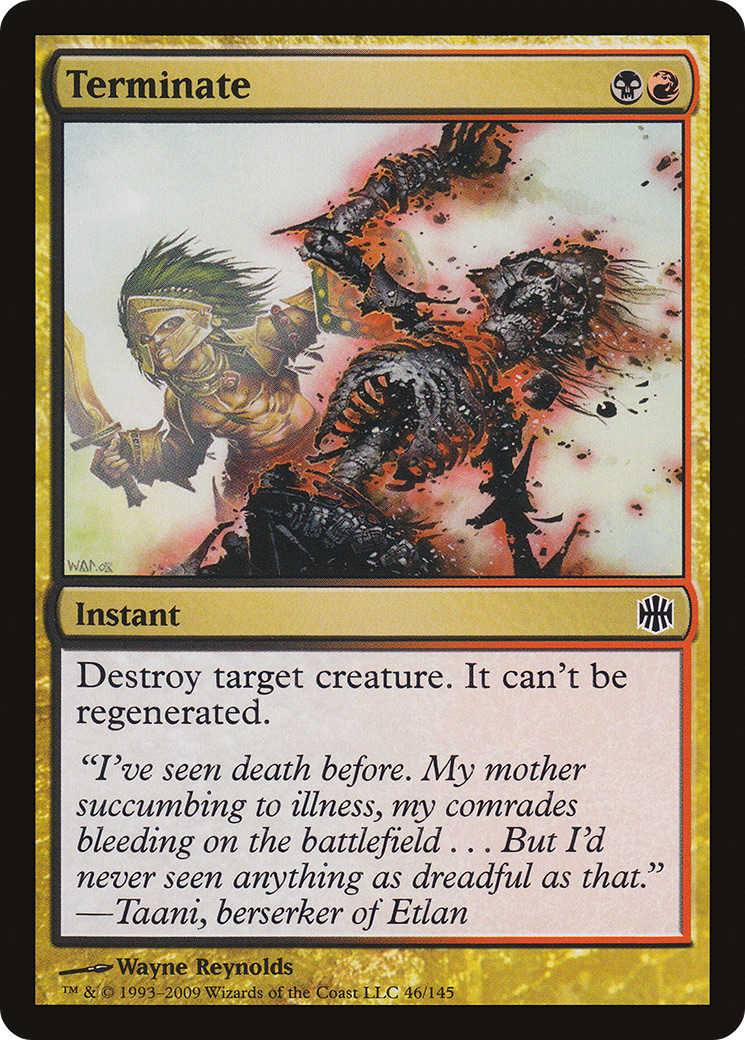
Guardian of the Guildpact is a good blocker and it helps us holding the door, allowing us to focus on destroying only the auras that give trample.
Destroy Evil can remove enchantments but it can also destroy Freewind Falcon when it is enchanted. This flyer is often sided in, hence I don’t cut any Journey to Nowhere.
.
Mono U e UR Faeries

The sideboard plan in these MUs are identical, that’s why I put them together. We have an easier time against UR as, even though they run some additional removal spells, they are way less aggressive in the early game. Against monoU, we struggle a bit more, especially if they happen to ninjtsu early and then lock us with their cheap interactions.
In these MUs, our fliers shine bright, as well as Dawnbringer Cleric, which blocks well and can destroy Moon-Circuit Hacker, Saruli Gatekeepers, which they have a hard time countering and can stop the race on the ground, and Sacred Cat which, once it is pumped with Basilisk Gate in the mid-late game, wins singlehandedly with its lifegain.
Side In:




Side Out:




We cut the non-relevant one-drops, as they are too easy to counter with Spellstutter Sprite, and Saruli Gatekeepers, as I never want to see it in the starting hand but I want to have access to at least one in the mid-late.
.
Affinity

The MU against Affinity is favourable if we manage to aggro them early with our Kor Skyfishers as well as immediately answer Makeshift Munitions. In this scenario, we are often able to win game 1, provided they don’t deploy 2/3 Myr Enforcers on turn 3 or 4. Then, once we sided in 4 Dust to Dust, the coast should be clear.
Side In:








Side Out:








I really like Pyroblast against Affinity, as it is the perfect support for Dust to Dust, protecting it against opponent’s counterspells. Also, it counters Kenku Artificier, Thoughtcast and Gearseeker Serpent in the Affo Monsters variant.
Regarding this last scenario, we can cut the second Ephemerate for a fourth Pyroblast.
Against normal Affinity, I keep one Ephemerate in to protect our creatures from Galvanic Blast o to repeat Dawnbringer Cleric’s etb and remove a creature from the graveyard in response to Blood Fountain’s activation.
There is a series of reasons why I don’t side in Relic of Progenitus:
- Dust to Dust exiles the artifacts, hence, in the mid-late game, we would exile their Myr Enforcers or even their Blood Fountains, which could be removed by Smash to Dust as well;
- Journey to Nowhere exiles creatures;
- With Dawnbringer Cleric, we can exile the few creatures that actually hit the graveyard and annoy us, such as Kenku or Krark-Clan Shaman;
- In this MU I don’t want any anti-synergy with cards such as Sacred Cat or Omen of the Dead, which are both fundamental to develop the game. Given how they can remove our creatures in response to Relic of Progenitus’s activation, exiling a Sacred Cat or a Kor Skyfisher from the graveyard could turn out being lethal.
All in all, I see it as a suboptimal card we would use only in response to Blood Fountain activations.
Destroy Evil hits both Makeshift Munitions and many creatures, such as Myr Enforcer, Gurmag Angler or Gearseeker Serpent.
Lightning Bolt, on the other hand, only works against Frogmite, which is not a problem at all, as we can easily block or double-block.
.
.
UW Gates

Against UW gates, we usually win, as they are much slower than us at activating Basilisk Gate (which they neither can tutor).
Dawnbringer Cleric dominates the MU, countering their The Modern Age, Journey to Nowhere, Sacred Cat or Prismatic Strands when they are in the graveyard.
They can win if they manage to set up a race/counter-race with Sacred Cat or Guardian of the Guildpact and the support of some Prismatic Strands to annul our attacks.
Side In:








Side Out:






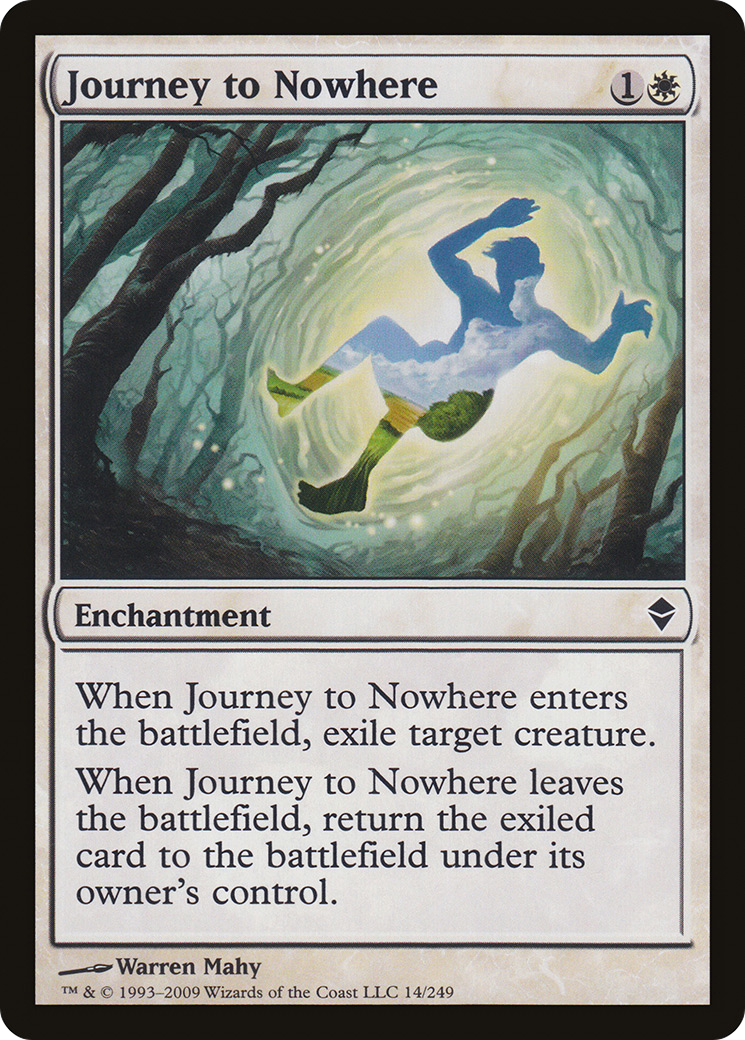

Pyroblast counters their own counterspells or their draw spells, if we want to be play aggressively. I don’t side in the full playset because they actually target their Counterspell only, hence having two copis in hand results redundant; even more so, our opponent could easily play creatures or enchantments during their turn to be in the game and, if they are often with mana available, that’s because they need to cast Prismatic Strands from their hand.
Guardian of the Guildpact is a free block for Sacred Cat, as well as being a 2-turn-clock if our opponent doesn’t have access to Strands or a Sacred Cat to counter-race. Once it hits the battlefield, there are no cards in their deck that can deal with a Guardian of the Guildpact.
Relic of Progenitus are a 2 additional ways to exile Prismatic Strands and Sacred Cat from the graveyard; moreover, we don’t have anti-synergy problems in this MU, given that they don’t run instant-speed removals.
Destroy Evil works as an additional removal that can both destroy enchantments and Basilisk Gate-buffed creatuures, as well as Coalition Honor Guard, a card that crushes us.
Lightning Bolt and Smash to Dust aren’t really powerful in this MU, due to Prismatic Strands preventing the damage, but they help fighting Sacred Cats (which will be later removed from the game with Dawnbringer Cleric or Relic of Progenitus) and Squadron Hawks or destroying a creature in response to Basilisk Gate’s activation (Bolt in particular).
Journey to Nowhere is ok, even though they run Dawnbringer Cleric as well, because it can remove a Sacred Cat token or, just like Terminate and Destroy Evil, a Coalition Honour Guard. That’s why I keep it as a 1-of.
If we are scared of Dawnbringer Cleric, we can use Journey on the Coalition Honor Guard only during the turn we want to close the game.
.
Mono R Synth e BR Burn

Against monoR, if they don’t start ultra-strong with a Monastery Swiptsfear and some Reckless Impusles, we shouldn’t struggle too much. If we manage to hold the board during the first few turns and also gain some life points with Saruli Gatekeepers, then we have a clear path to Sacred Cat + Basilisk Gate to win the game.
Against the latest versions, which run 8 impulses and Thermo-Alchemist, Smash to Dust remains effective, as it can remove the 0/3 wall.
The deck is set to win against monoR already in game 1, given how popular it is online; hence, I don’t have anything to side in.
The MU against BR Burn is a bit different, because we have Dust to Dust post side to try and attack their mana base. Also, they run less creatures, so we could end up having multiple removals in hand without the opponent having any creature on the battlefield but continuing the spell-based burn strategy that annoys us quite a lot.
Side In Br Burn:



Side Out Br Burn:



I side in only 3 copies of Dust to Dust because BR Burn doesn’t run too many artifact lands, but we can still spike some Scrapwork Mutts and the Blood Tokens. Having access to just one copy is enough to slow down their gameplan, given that I don’t want to give up other strong maindeck options.
I cut Journey to Nowhere instead of Terminate because the instant-speed removal comes in handy against Kitchen Imp. Moreover, we have to keep in mind that we have a free block for said Imp in Kor Skyfisher, so we don’t really need too many removals in this MU.
Tips: against these decks, we shouldn’t be greedy and immediately play Kor Skyfisher. If we bounce a Saruli Gatekeepers and the redeploy it, the game is basically over. The same goes for Ephemerate: if we aren’t that much behind, we always use it in response to a removal on Saruli Gatekeepers.
.
RG Ponza

The MU against RG Ponza revolves around how many lands we see during the first few turns, which means, how much we can even out their land denial.
Gatecreeper Vine with Ephemerate and Kor Skyfisher makes it possible for us to always hit land drops, even if some of our lands get destroyed.
Dawnbringer Cleric is unmatched during the early turns, as it can significantly slow down their gameplan destroying the enchantments such as Utopia Sprawl. This nets us the time we need to develop our gameplan.
Lightning Bolt is crucial both in the early as in the mid-late game, as it can remove Arbor Elf in the first turns and then it can hit some of their menaces, such as Boarding Party.
Side In:






I board in Guardian of the Guildpact because it is a good blocker and they don’t have a way to answer it. Alongside the fliers, it helps us closing the game as well as easily taking the initiative when they play Avenging Hunter.
Destroy Evil works as always as the fifth enchantment removal, but it can also hit Avenging Huner and Annoyed Altisaur.
Tips: they don’t play that many removal spells, usually only 3 Skreds, hence Ephemerate on Gatecreeper Vine can be cast pretty aggressively in order to never be behind land-wise.
We can Ephemerate Kor Skyfisher as well to bounce a land in response to land destruction effects. I suggest to do so in particular with Mwonvuli Acid-Moss, so that the spell fizzles and our opponent won’t even tutor for a forest
.
MU Equilibrati
I refer to all those MUs in which the win rate is between 60% and 40%
Sadly, I don’t have enough data to have a clear idea on this range of MUs.
Perhaps, on the long run, monoU Faeries, against which the win rate fluctuates around 60%, and BW Ephemerate, against which we have a win rate around 40%, will be part of this classification as well.
Given this lack of substantial information, I put in this group the midrange/control decks against which I matched up pretty equally.
- Jeskay Ephemerate
- Mardu Syinth
- BG Gardens
.
Jeskai Ephemerate

Jeskai runs a lot of cards that hinder our gameplan. Cleansing Wildfire, which can be recurred and re-casted, as well as the various burn-based removal spells interact well with our strategy. Counterspell allows them to remove our menaces and the Archaemoancer loop is hard to deal with, at least in game 1.
Side In:










Side Out:










Pyroblast and Relic of Progenitus are very good at blocking their strategy since the early game, while Guardian of the Guildpact wins singlehandedly when it hits the board.
I don’t side in Dust to Dust because the latest versions only run 8 artifact lands, so it’s pretty hard to cast on turn 3 or 4 and it becomes very bad the more the game develops.
Given the reduced number of artifact lands, Jeskai doesn’t play Kenku Artificier any longer, so we really don’t need to keep Journey to Nowhere in the deck, given that they play Dawnbringer Cleric as well.
.
Mardu Synth

The MU is similar to that against Boros Syinth, but here they can also slow us down with Cleasing Wildfire on our Basilisk Gates, and they also have the Kor Skyfisher + Omen of the Dead recursion that hinders us even more and allows them to make the games even longer.
Given how they run land destruction and many removals, I consider it a MU similar to Jeskai.
Side In:








Side Out:








Dust to Dust comes in because, even though they run no more than 9 artifact lands, contrary to Jeskai, it is pretty efficient at removing their rocks. Also, given how mana-intensive their spells are, attacking their mana base is fundamental.
Relic of Progenitus is an additional tool to remove pesky spells from the graveyard, such as Chainer’s Edict, and to stop their Omen of the Dead.
Guardian of the Guildpact can take the game away in a few turns if they don’t find Terminate.
Saruli Gatekeepers isn’t really useful, as Mardu runs way less burn spells and, opposite to boros, they don’t attack us during the first turns.
I keep one Ephemerate to potentially spike a Omen of the Dead at instant speed with a Dawnbringer Cleric or to remove a Kor Skyfisher from the graveyard in response to Omen of the Dead.
I cut Journey to Nowhere because, even though exiling a Glint Hawk or a Kor Skyfisher instead of sending them to the graveyard is extremely powerful, once the enchantment is removed by a Dawnbringer Cleric, we end up way too far behind, as the etb of the once-exiled creature will trigger again.
.
BG Gardens

This deck runs a lot of cards able to remove our threats, Crypt Rats most of all, while never running out of gas. Nonetheless, if we manage to take the initiative, they have a very hard time getting it back and we can smoothly win from there.
Side In:




Side Out:




Our plain is to deploy as many creatures as possible to annul their Chainer’s Edicts trying to hit Guardian of the Guildpact, which can win on its own, while hoping to avoid Crypt Rats.
Smash to Dust doesn’t really do anything besides removing Blood Fountain, which I prefer to take care of with Dawnbringer Cleric and Relic of Progenitus.
We cut Ephemerate due to Spinning Darkness and Snuff Out.
.
MU Negativi e Super Negativi
I refer to the MUs with a win rate below 40%
These include:
- BW Ephemerate score: 8-13 wr 38%
- MonoR Hotdogs score: 4-8 wr 33%
- Walls Combo score: 3-9 wr 25%
- Flicker Tron score: 2-10 wr 17%
.
BW Ephemerate

Among all the decks mentioned above, this is the one against which we suffer the least. Our strategy is that of removing their creatures early, both with trades and removals, so that we can steal the initiative and start the race. If they manage to stall the board and progress in the dungeon, our chances of victory shrink; we can try to propel the Sacred Cat + Basilisk Gate combination, as this strategy grants us quite a lot of tempo, but this would end up quenched as well on the long run.
A powerful ally in this MU is Dawnbringer Cleric, which removes the Spirited Companions and also, when facing the Kor Skyfisher variants, the creatures they could recur with Omen of the Dead
The fliers do a bunch of work as well, as they can deal some cheap damage in the early game and then they make the Initiative game way harder for our opponent.
Side In:



Side Out:



Guardian of the Guildpact to pass through their wall of blockers and to steal the initiative and win the game.
They usually run at least 2 copies of Unmake, so we absolutely need to keep Ephemerate in to blink Skyfisher and bounce the Guardian, given how crucial it is in the matchup.
Destroy Evil is used to remove Goliath Paladin, Vampire Sovereign and Coalition Honour Guard.
Even though BW usually runs at least 2 Dawnbringer Clerics, I keep in 2 copies of Journey to Nowhere nonetheless, as it can remove the creatures mentioned above and also it can slow down their development in the early turns, putting off the arrival of the initiative,
I keep Smash to Dust in to have a way to clear the board from our opponent’s X/1s, which usually are around 10 or so, dodging Ephemerate.
.
Hot Dogs

If we don’t kill Klin Fiend or one of its friends on sight, we usually die with just one swing. Lightning Bolt could turn out being not-that-effective as well, given that they run Mutagenic Growth as a 4-of.
Sacred Cat + Basilisk Gate and Saruli Gatekeepers could give us somewhat of a hope, but we usually don’t have enough time to survive.
Side In:


Side Out:


Guardian of the Guildpact because it is a free block if they don’t play Temur Battle-Rage. Still, we need to look out for Flaring Pain which, if sided in, denies the Guardian’s protection. However, with it being a 4-drop and given that the creature they attack with is irrelevant, I can only justify siding in 1
Destroy Evil because for sure it will do more work than Smash to Dust and we hope to snipe a Mutagenic Growth-pumped creature or a Monastery Swiftspear after the second spell of the turn.
.
Walls Combo

Against Walls as well we have almost nothing to say. Winding Way and Lead the Stampede allows them to rebuild quickly even if we manage to remove some creatures in the early game. They can also rely on creatures with reach to block our fliers and artifact walls to stop our Guardian of the Guildpact.They can recur creatures from the graveyard to combo off even if we manage to interrupt them one time.
Our win conditions are either they whiff or we manage to race them on turn 6 with a double Basilisk Gate and a flyer.
Smash to Dust is extremely versitile, as it can both remove a specific wall or clear out their X/1s depending on the development of the match, granting us some very much needed time. Nonetheless, post-side, they have the Crimson Acolytes to prevent this interaction as well.
Side In:











Side Out:











Our plan in game 2 and 3 is to use Pyroblast to counter Galvanic Alchemist or Freed from the Real and then remove their graveyard from the game with Relic of Progenitus in response to Reaping the Graves or Pulse of Murasa. Yet, this couldn’t be enough, as their deck can produce a lot of mana even without the combo and then proceed to kill us in 2 or 3 turns with Valakult Invoker.
Guardian of the Guildpact can steal the game in 2 or 3 turns if they don’t play Shield-Wall Sentinel.
Destroy Evil gives us an additional answer to Overgrown Battlement or Wall of Roots.
I cut Sacred Cat and Saruli Gatekeepers because the amount of life we gain is irrelevant
.
Flicker Tron

In this MU we barely have any interaction to stop their plan, especially in game 1. They can also stop our faster starts with Basilisk Gate thanks to Moment’s Peace and Stonehorn Dignitary.
Side In:











Side Out:











Pyroblast to snipe Mulldrifter and Mnemonic Wall above all.
Relic of Progenitus to support the Dawnbringer Cleric + Ephemerate duo in preventing the recursion with Mnemonic Wall and the use of flashback cards.
Guardian of the Guildpact to try to steal the game through blockers.
Destroy Evil as an instant-speed removal for Mnemonic Wall, Dinrova Horror and Stonehorn Dignitary.
I cut Sacred Cat and Saruli Gatekeepers because we don’t care about gaining life.
Journey to Nowhere doesn’t do anything, as they run very few creatures. Also, I prefer Lightning Bolt as an instant-speed interaction with Mulldrifter and to have a bit of reach if we manage to drop their life total low.
We keep Smash to Dust in as some early removal on Expedition Map or Energy Refractor could grant us the possibility to end the game before they actually start playing.
.
“Distorted” MUs
There are certain MUs where the gaming platform actively makes a difference, so I want to consider them in a specific category. The quantity of clicks required, the difficulty in closing the game out and some slight changes in the strategy, at least online, give us a good win rate, with quite a lot clock wins. Nonetheless, this could be different IRL.
These MUs include:
- UW Familiars score: 11-6 65% wr
- Altar Tron score: 6-0
Their strategy is that of potentially starting a loop that requires a lot of clicks and several interactions, especially when producing infinite life points. This doesn’t mean we have lost the game, but rather that we let them use their clock while they slowly kill us.
On the other hand, if they were to gain infinite life IRL, we would have to concede the game, as the clock is shared. Of course, infinite life is not something we can beat so we always give up, unless it is game 3.
For this reason, I see a fundamental difference between IRL and MTGO play, but I also think both of these MUs would be among the negative ones.
While playing on MTGO, I don’t think that making the opponent lose time is a coward move. Quite the opposite, I think having two separate clocks for the two players is as equal of a condition as it gets, as it forces players not to lose time, an attitude that is becoming increasingly more popular in paper Magic.
Also, I think we should keep in mind that these decks that inherently are at danger of losing due to timing out, at least online, so they aren’t really popular.
.
UW Familiar

Against Familiars, game 1 is much more difficult than the other two games. We can think about stealing it only if the opponent gets stuck on lands and we manage to race them with flyers. Lightning Bolt and Smash to Dust on their Sunscape Familiars could buy us that additional turn we need to close the game.
Side In:










Side Out:










Pyroblast and Relic of Progenitus to have two ways to prevent them from going off.
Guardian of the Guildpact singlehandedly wins the game if it resolves.
I always cut Sacred Cat and Saruli Gatekeepers because we don’t really care about gaining life.
Dawnbringer Cleric goes along well with Ephemerate in this MU as well, but we are ok with it being a 1-of, since both The Modern Age and Prismatic Strands are way less popular now, so we only want to spike specific cards from their graveyard, perhaps in response to an Archaeomancer trigger.
I keep Journey to Nowhere in because the latest versions play only one Dawnbringer Cleric and removing a Familiar on turn 2 or 3 is always good.
.
Altar Tron

The plan against this deck is to go as fast as possible and close the game with Basilisk Gate before they win.
When encountered on MTGO, this deck plays more “aggressively”, meaning they deploy key parts of the combo (such as Golem Foundry), even though they don’t have the other pieces in hand, trying to quicken the game and not timing out. This allows us to play and optimize Smash to Dust and Dust to Dust, even though we can only play them at sorcery speed; when playing IRL, this doesn’t apply, as players tend to put these pieces on the battlefield only during the turn in which they want to go off.
We can also destroy Myr Retriever at the end of our opponent’s turn or during our turn and then remove it from the game with Dawnbringer Cleric. Said Cleric, if combined with Ephemerate, can also be used to stop the combo as it is starting by exiling the Myr Retriever target by the other one.
Side In:








Side Out:








We hope to slow them down with Dust to Dust’s 2-for-1.
Relic of Progenitus helps us a lot, especially if we see both of the 2 copies, given how hard it is for them to remove it and that they always need to go through the graveyard to win (which means they are at risk of losing 2 Myr Retrievers if they try to do so).
Once again, the lifegain package is useless, thus we cut it.
I keep all the removals in, so that we are always able to deal with the Retrievers and also because they may side in Fangren Marauder.
I would like to write about many other decks, but I don’t have enough data to give an objective opinion; the ones mentioned are the MUs I encountered the most in these 5 months.
.
Extra Cards
After this long chapter about MUs and sideboard options, I’d like to dedicate some thoughts to certain cards I either tried but didn’t like, would like to try or that you should avoid playing.
All in all, I think the deck could easily be tweaked depending on the metagame; right now the curve is low to better answer monoR’s aggression. In an alternative future where Monastery Swiftspear isn’t as oppressive, we could easily add some heavier cards that allow us to develop our gameplan.
.
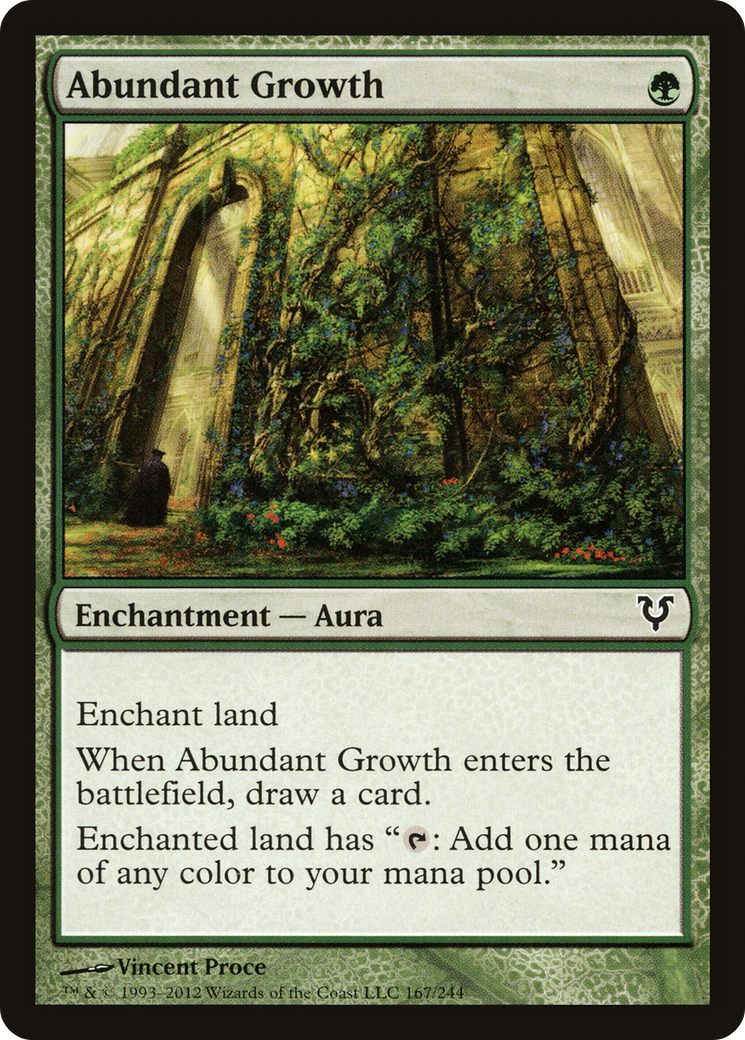
This card was played in the first drafts not to fix mana but rather as a possible Kor Skyfisher target. As I played the deck, I noticed I was always boarding out Abundant Growth and I didn’t have any problem finding targets for the Skyfisher.
Hence, I initially cut one to add one more Dawnbringer Cleric, which would later become a 4-of removing one Omen of the Dead, given how it can be a target for Skyfisher too.
As I played more games, I cut the second one as well, in order make space for an additional creature, such as the third Saruli Gatekeepers or the mono Guardian of the Guildpact.
.
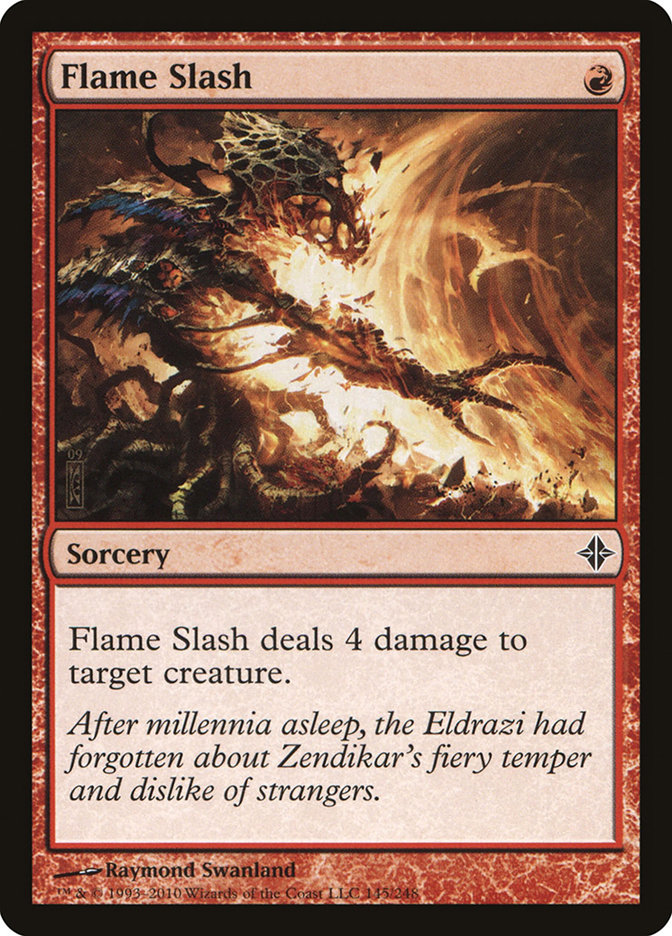
Some lists include Flame Slash over Lightning Bolt mainly to remove the creatures with higher toughness, such as Myr Enforcer or Avenging Hunter.
I think that having the possibility to play at instant-speed rather than sorcery-speed is much more important in those MUs where we want to interact in response to an opponent’s choice. Or we simply want to remove Swiftspear.
The additional damage makes a difference only against a limited number of creatures in the current meta, whereas an instant-speed spell that can also target an opponent is way more valuable.
It can be considered if the meta becomes more non-blue-based midrange and there’s no need to play at instant speed.
.
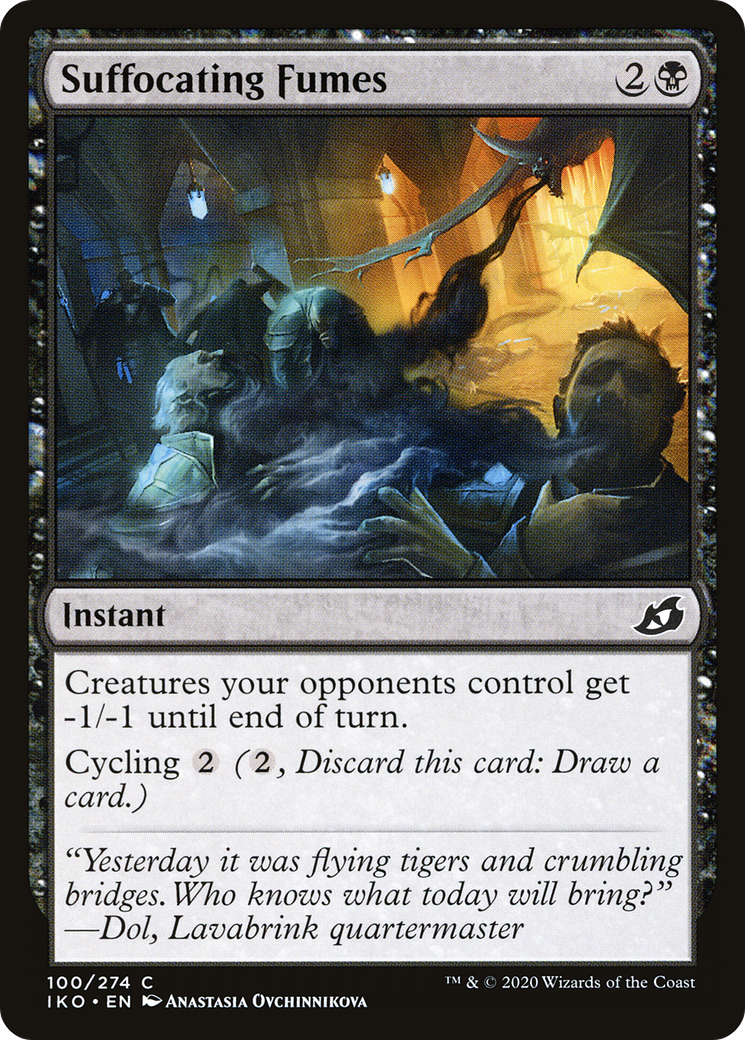
It’s a viable card because it is an instant and it can be cycled in the MUs where it is useless, thus never really being a dead card.
The actual problem in my opinion is that, within the shell of this deck, it would be almost impossible to cast it on turn 3 even if we needed to, given the number of tapped lands and the situation of black mana fixing.
Still, Smash to Dust is a much more flexible card in the current meta and it’s much easier to cast during the early game as well. All of this evens out the lack of a cycling ability and the sorcery-speed restriction.
If the meta was to be repopulated with Caw Gate, Elves or Boros Bully, then Fumes would be a card to take into serious consideration, as it allows to answer to our opponents’ interactions.
.
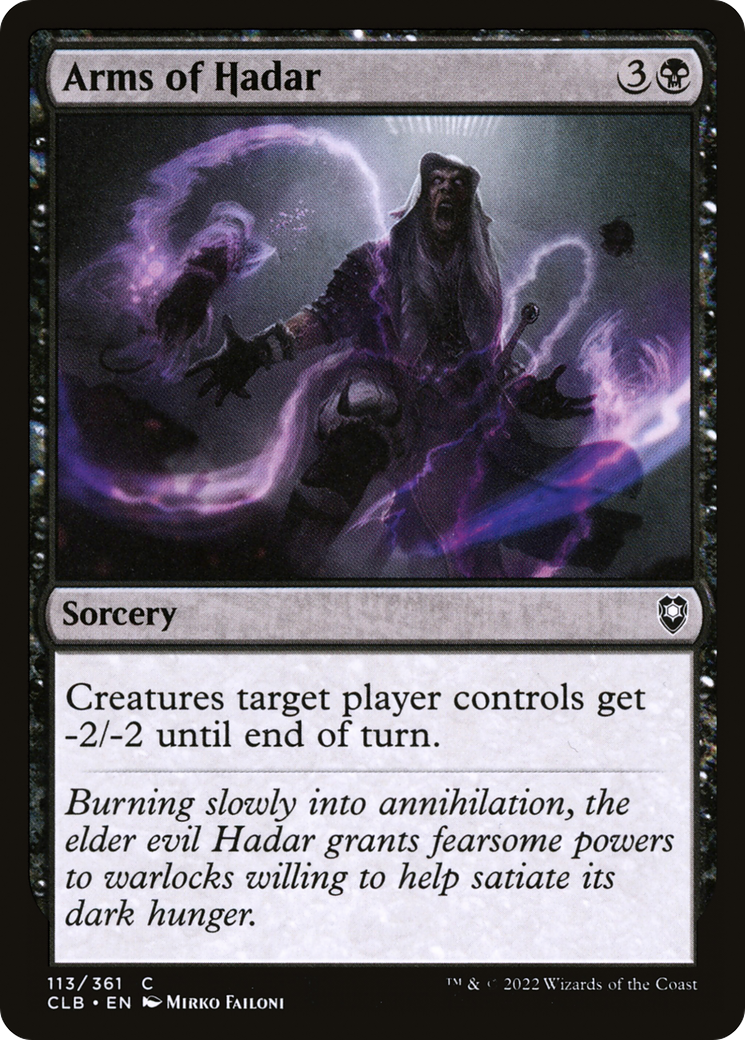
I would play this wrath effect only as a 1-of in the side to have an additional answer in a meta full of MonoW, Faeries, Boros Synth and Boros Bully.
Some lists put it in the main deck, but having a card that is a dead draw in a lot of MUs doesn’t sound as a great option to me, given how we don’t have any way to discard or “recycle” it if we happened to draw it in a spot in which it isn’t useful.
Yet, it remains a meta-dependant card, especially for more aggressive environments. Right now, other wrath effects that deal even just one damage are more than enough.
Moreover, considering the volume of tapped lands in the deck, the casting cost becomes a problem, and it is only worsened by the sorcery-speed restriction, which makes us weak to the many available instant-speed interactions, especially when referring to Faeries.
The only real advantage we could have is that, with it being a black card, it could be more difficult for our opponents to predict it and to play around it.
.
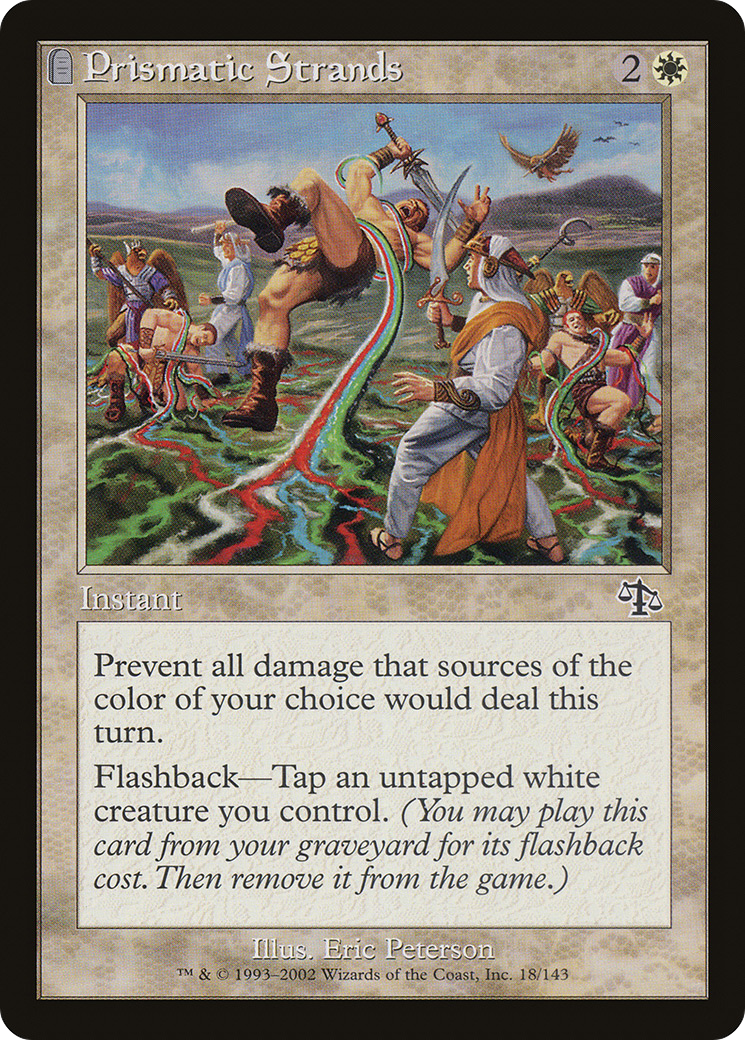
Prismatic Strands is a powerhouse against monoR, Hotdogs and aggro in general, but this deck, contrary to Caw Gate, doesn’t have any way to optimize it by discarding it. Moreover, we would have only a handful of viable time spots in the mid-late game in which to keep 3 mana open to cast it.
It could be a 1-of, but I wouldn’t suggest playing more copies, as it is pretty difficult to have available untapped mana until turn 5 or 6; even more so, at certain point we want to be activating as many Basilisk Gate as possible, hence keeping 3 mana open isn’t really what we aim to do.
Nonetheless, in a Hotdogs-heavy meta, I would for sure take into consideration playing it, even as a 2-of.
.
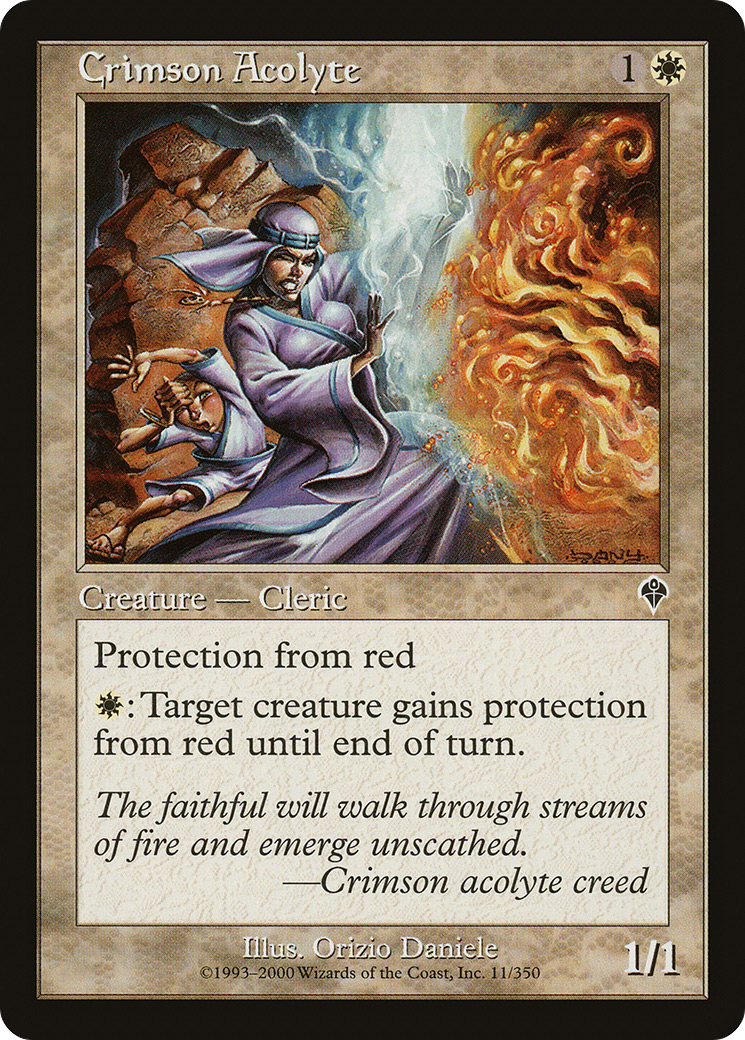
Just like Prismati Strands, this funny guy singlehandedly takes care of the MUs against monoR, but it also has the same problems: it requires a huge mana investment, which is not exactly achievable in a deck that is almost always tapped out. Moreover, the monoR MU is already fine as of now.
Again, if the meta was to be overrun by Hotdogs, then I would consider including 2 or 3 copies in the side, as they could also give protection to our opponent’s creatures, hence making fizzle the spells that target Kiln Fiend and/or its friends.
.
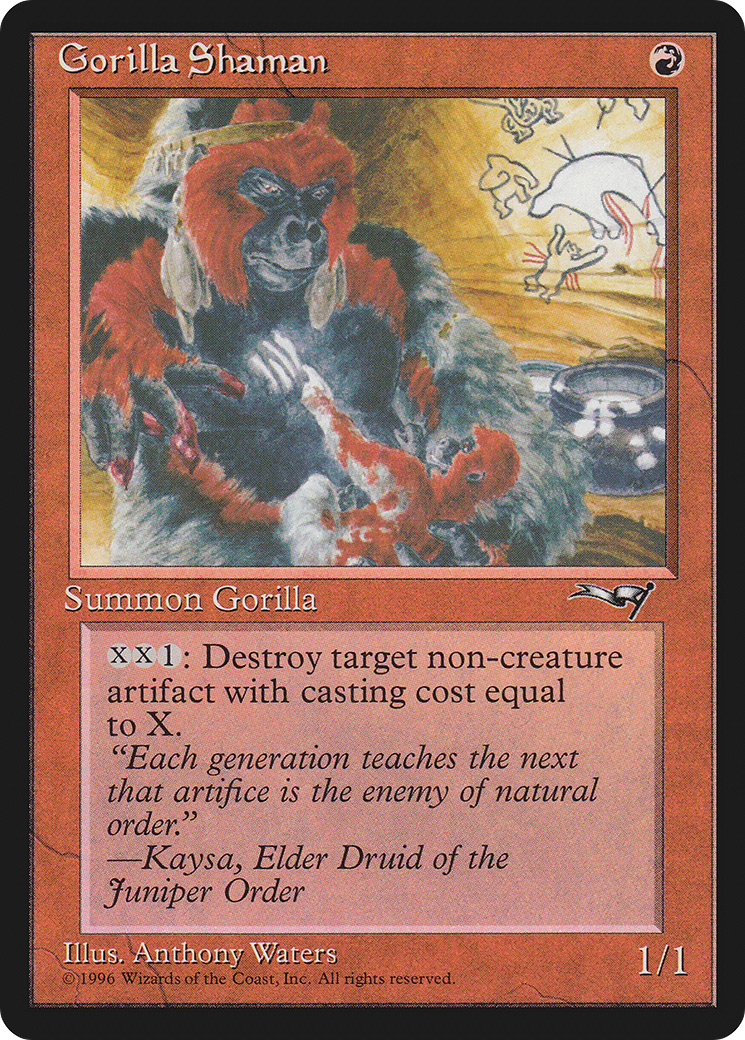
This could be the fourth/fifth sideboard card against Affinity and it could also help against Boros Synth and BR Burn.
Yet, we already have a positive MU against these decks and it would be another creature, alongside Sacred Cat and Inspiring overseer, that gets completely owned by Makeshift Munitions. I’d much rather have the full Dust to Dust playset in sideboard.
.
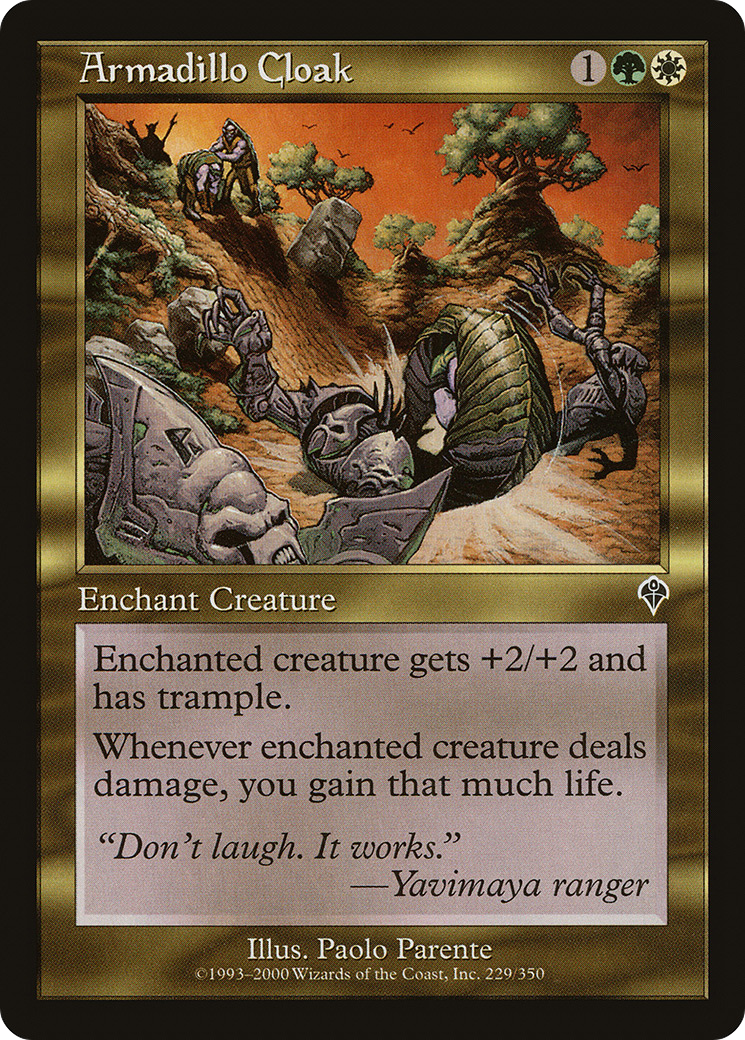
This card is simply unbeatable in a shell with Guardian of the Guildpact and it is totally viable due to the monoR-dominated meta. Still, I don’t play the Guardian in the maindeck but, most importantly, it would be yet another card in the high end of the curve; as of now, I prefer to play Inspiring Overseer as my 3-drop, as it cycles itself and it is an evasive creature to close the game.
If I was to play it, then I likely would have to revisit the whole top end of the deck.
.
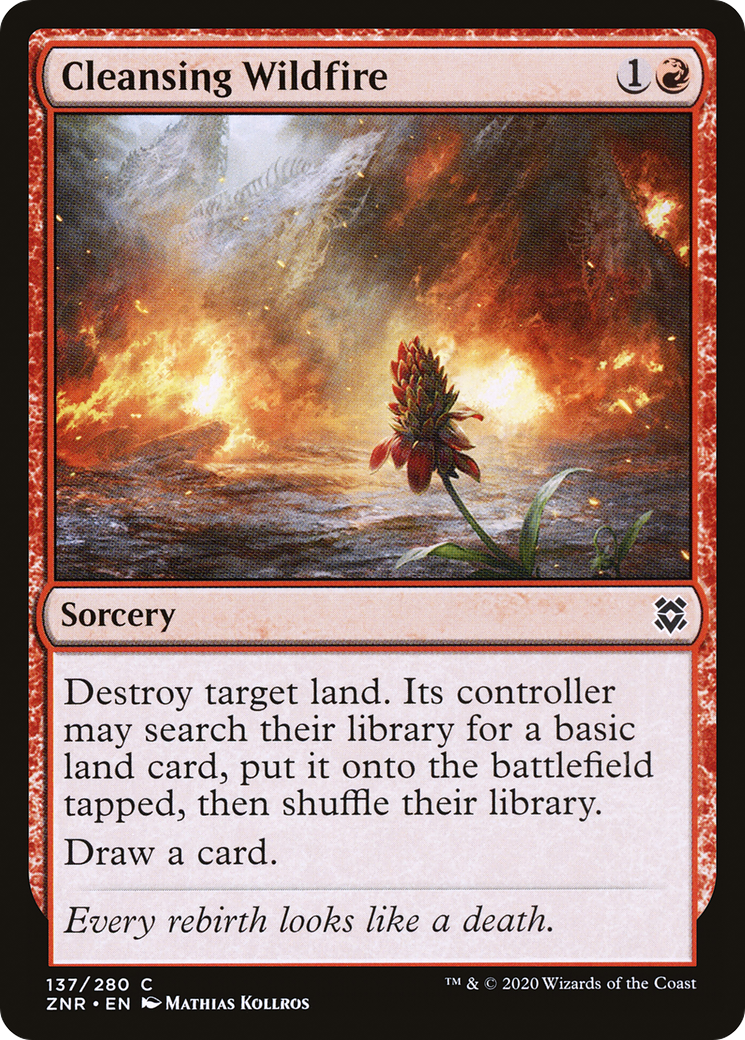
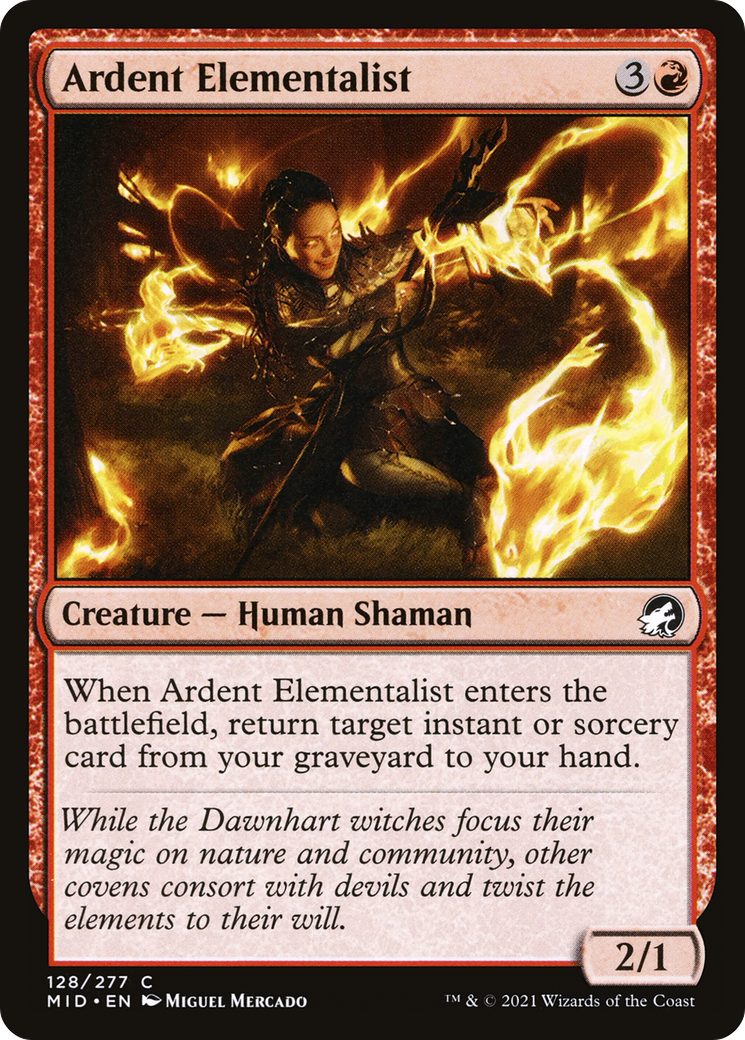
The only potential way to beat the Tron decks would be to have 2 Ardent Elementalist and at least 3 Cleansing Wildfire in the sideboard.
I tried this “package” for a short period in which Flicker Tron was more present in the meta, but I noticed that if we don’t start looping it immediately with Ephemerate, destroying just one of the three Urza lands doesn’t really achieve much.
Moreover, playing at least a few copies of Relic of Progenitus is a must, which generates a clear anti-synergy with Ardent Elementalist, also considering that we wouldn’t have a lot of other instants or sorceries to recur with it.
In any case, I would always choose Cleansing Wildfire over Stone Rain, as the first could be a turn 2 or turn 3 play, while the latter would likely be played on turn 4, when our opponent would have already assembled Tron, thus having much more options to answer our spell.Even more so, Wildfire cycles itself hence, in an optimal recursive package, it would be much more powerful, provided that Tron decks usually run just 1 or 2 basic lands.
.
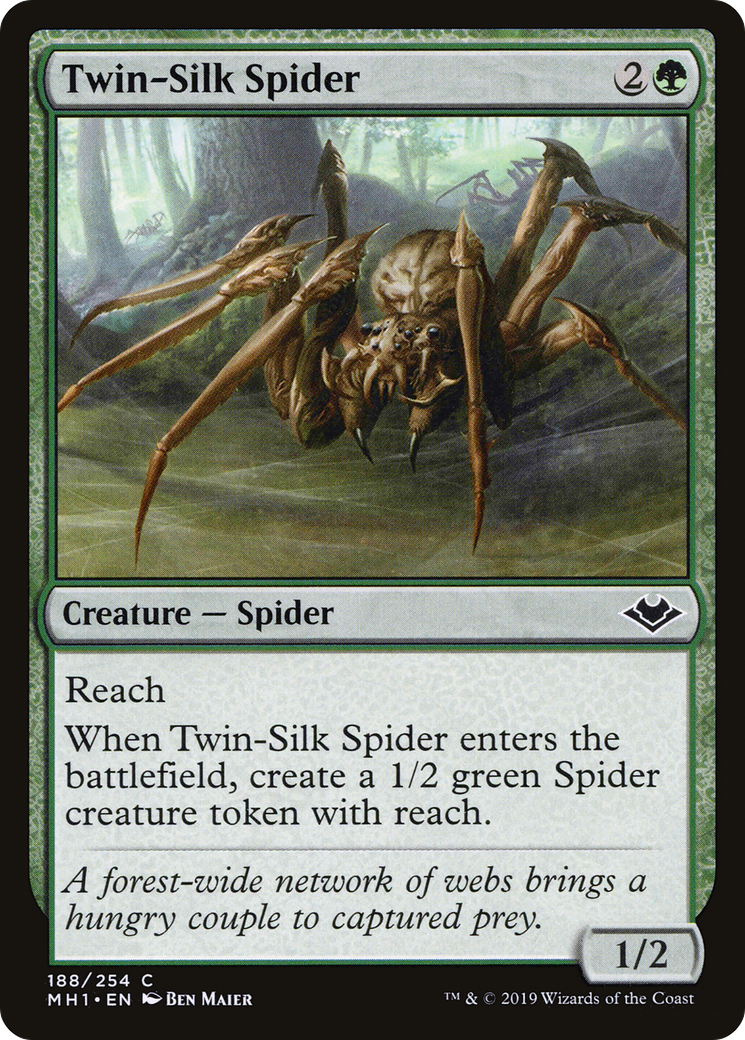
An interesting little spider at 3 mana that could be useful in the MUs where you want to double block some X/1s, monoU Faeries above all; it could be useful against Kuldotha Rebirth as well, as the token it brings with it de facto annuls the threat generated by that card.
As of now, given that our answers to Faeries are more than abundant (7 fliers, 4 Bolts and 4 Pyroblasts post side) and that monoR doesn’t run the artifact package any longer (which means there are no more Goblin tokens and Voldare Epicure to be blocked), I wouldn’t consider this as an option. Yet, I recognize it would fit with the theme of the deck, as it could be a pretty good Kor Skyfisher target.
.
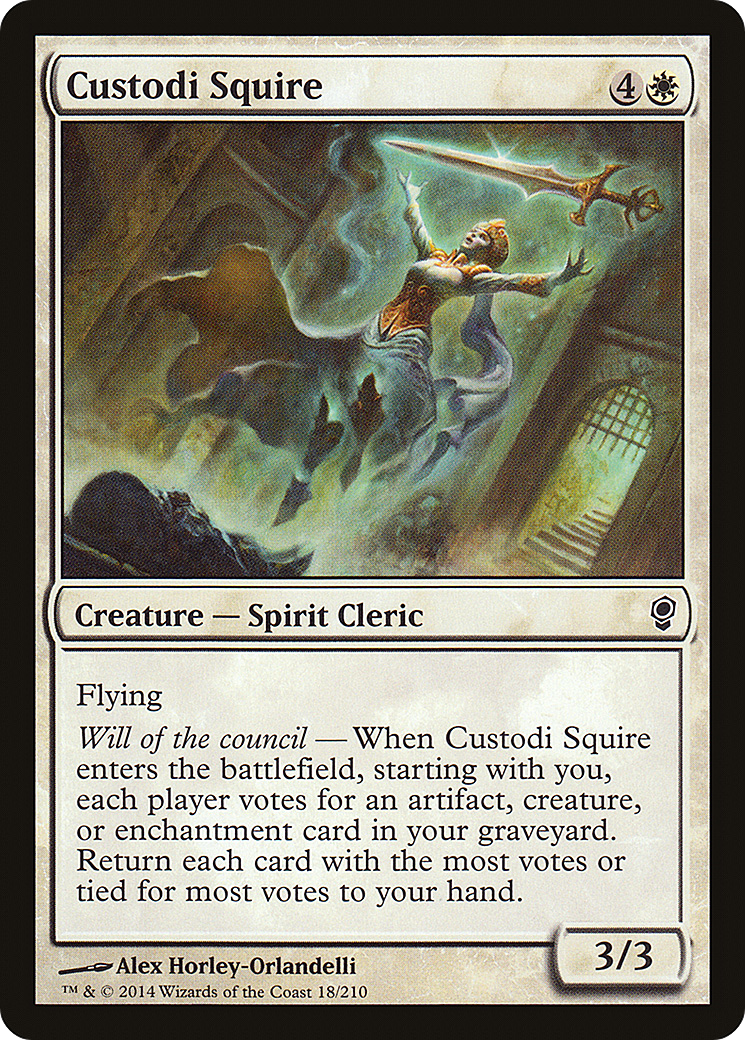
This card, in my opinion, matches perfectly with our gameplan, giving us even more tools to play the long game, considering how it could be recurred with Kor Skyfisher and, during even longer games, Omen of the Deads. Moreover, it is an evasive creature with a body that makes for both good blocks and attacks, even without Basilisk Gate.
Sadly, given the current aggressiveness of the format, it’s not possible to play it, but it would be for sure included if the meta was to shift towards midrange strategies.
.
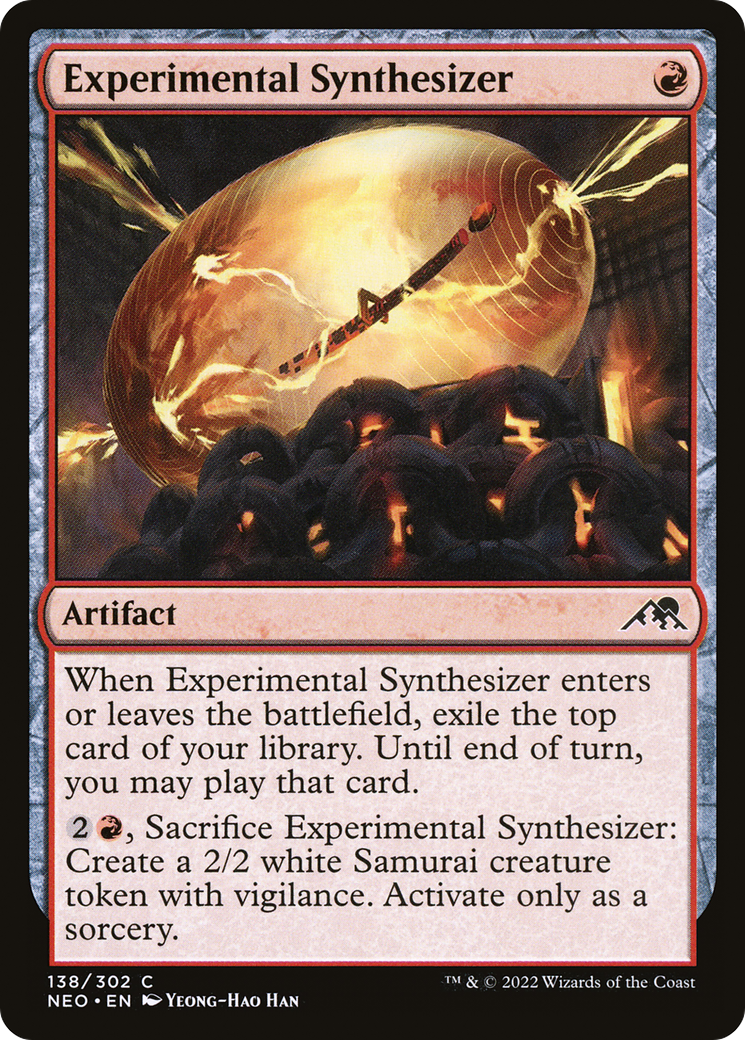
This is another card I would be more than happy to play if the meta was less aggressive, even if it wouldn’t be a 4-of, as we would only want to play it in the mid-late game. Most likely, it would be a 2-of at best, due to our 3 and 4-drops, which would make it playable only from turn 6 onwards, when we would have 4 more mana available. Moreover, to optimize its sacrifice effect, we would need 7 or more mana.
Within the deck’s strategy, it would fit perfectly, as we can use it to get access to 2 more cards using only one and it also generates a 2/2 toke that can be pumped with Basilisk Gate. Also, we would have the potential power play with Kor Skyfisher.
.
Final Considerations
Naya Gates isn’t a Tier 1 deck in the format for sure. Still, the current meta allows it to match well against the other popular and high-tier decks. I enjoy playing it a lot due to the variety of choices and plays it offers as well as the races it can establish as the game develops.
It can easily adapt to the evolution of the meta, if this was to become more midrange, whereas it would struggle in a more combo or Tron-heavy environment.
I really love the Gates mechanic and everything that comes with it, which is to say small sized creatures that generate value during the game and that can later be used to swing for a lot of damage thanks to Basilisk Gate.
This mechanic fascinates me because it is still unexplored and there are endless possibilities in the deckbuilding process, with a variety of shells and color combinations depending on the meta. As of now, I’ve chosen this 4c Gates variant, but I’m always looking out for new innovations, cards and color combinations.
I’m eager to know about the ideas and considerations you elaborated regarding the deck, as well as to hear about the changes you would make or the new color combinations or shell you would like to try.
If you have any question, you can find me here, and I’ll gladly address any doubt you have regarding the deck, the sideboard plan and the gameplay depending on the MUs.
I hope I have said everything that needed to be said, even if I think that I could go on and on writing about the deck.
.
Acknowledgements
I thank Pauperwave, which gave me the great oportunity to write some thoughts about this awesome deck.
I thank Daniele Baratella, who has become a dear friend of mine in unexpected circumstances and that more than anyone has encouraged me to appreciate the Gathering in Magic once more. He allowed me to establish new extraordinary and healthy friendships.
I thank Alberto Rascio, a long-time friend and partner during several sleepless nights spent playing with cards and testing weird decks found on the Internet. None of this would have been possible without him.
I’d like to thank the whole LP Padova as well, an awesome new pauper community in the area of Padua that brings together new players willing to grow and learn and expert players ready to teach and guide them with their knowledge.
Lastly, I’d like to thank Pietro Bragioto as whell, as he revised the whole article and most of all because he is a madman with whom I love to confront and talk to improve and evolve pauper decks through innovative and functional ideas.
Stay tuned, Stay Pauper
.

